The scene at Les Combes last Sunday morning, two Z4s a 458 Italia, a Vantage and a SLS lie abandoned and broken, like the dreams they once carried.
Endurance racing can be a cruel sport.
John Brooks, August 2013

Last week I caught up with our Special Correspondent in Belgium and he gave me the good news that he had finished his reflections on this year’s Goodwood Festival of Speed. So for the enlightenment of us all here is his copy and images.
A visit to the Cathedral Paddock at half past seven on the Friday morning is always well rewarded. Here we have the surviving 1939 V-12 Le Mans Lagonda, the work of W.O. Bentley and his team.
The two cars entered came 3rd and 4th, following obediently the speeds set by the master – he wanted to ensure reliability and to go all out for a win in 1940; but that of course never came. The two cars had their final outing in the very last Brooklands meeting in August 1939 before the war clouds moved in. A win in a handicap race for this car crowned their short career before a V-1 hit the garage where they were stored, doing considerable damage. This car represents the works car which took third place at Le Mans in the hands of Arthur Dobson and Charles Brackenbury.
Beware! – some replicas have been made but this is the only genuine survivor!
Anyone still somnolent at that time of the morning soon had their condition violently shaken by the shattering bombardment of noise from 12 short-stub flame-spitting exhausts of the 26.9-litre V-12 Liberty engine of Babs being warmed up – wonderful! Babs of course is the real restored car which that engineering genius Parry Thomas had developed from the Higham Special which he had obtained from the estate of Count Zborowski who had been killed at Monza in a works Mercédès in 1924. Thomas worked on the car for a year or so, re-naming it Babs, and in 1926 he set new World Land Speed records in April of 169 and 171 m.p.h. on the Pendine Sands in South Wales.
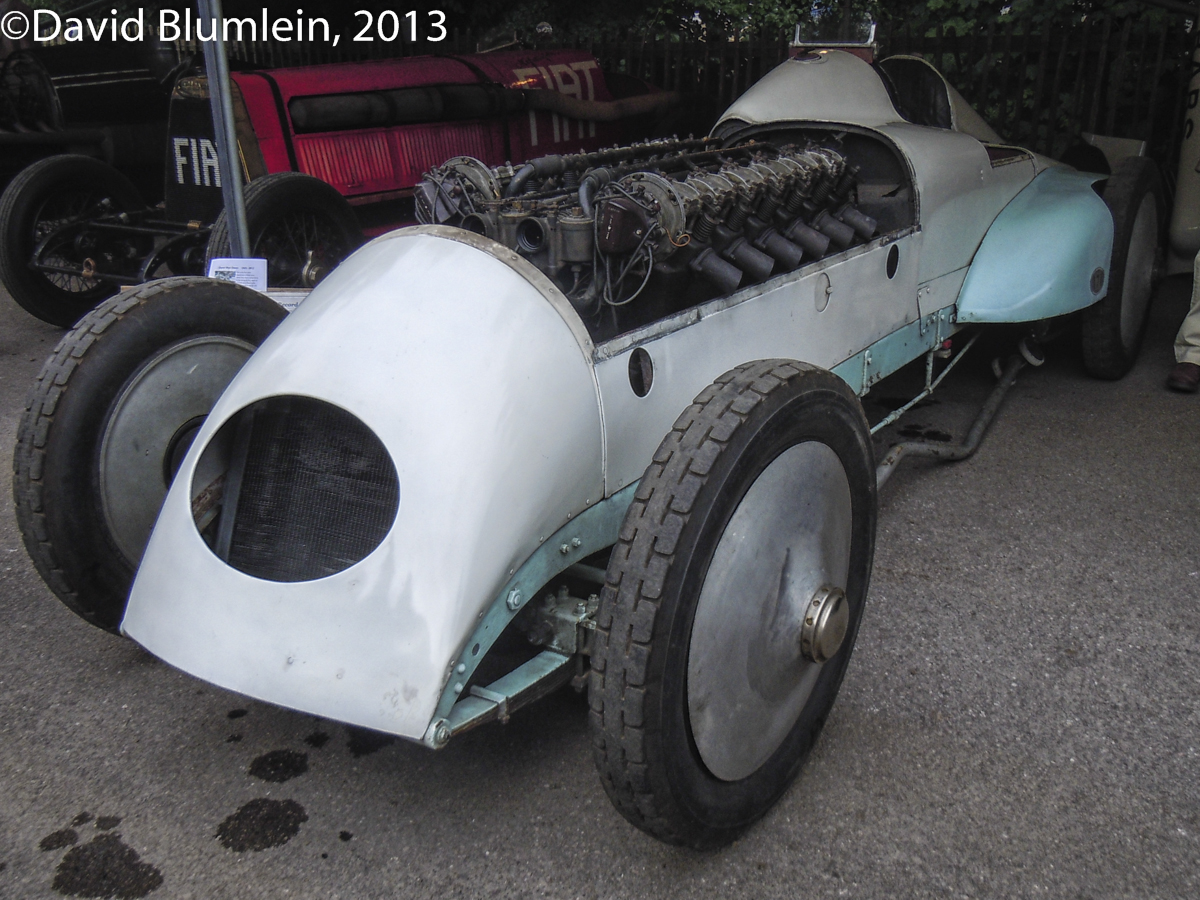
The car underwent further modifications prior to Thomas returning to Pendine in April 1927 to try to beat Campbell’s record of 174 m.p.h. set in February in Bluebird. Alas, he crashed fatally and the damaged car was buried forthwith in the sand. It was that enthusiast Owen Wyn Owen who obtained permission to dig up the remains and to restore the car to its original final state as we see here.
Speculation has for a long time suggested that the driving chain came off to cause the head injuries from which Thomas died but this is now discounted – the covers were intact – and it is thought that he lost his life when the car turned over on top of him.
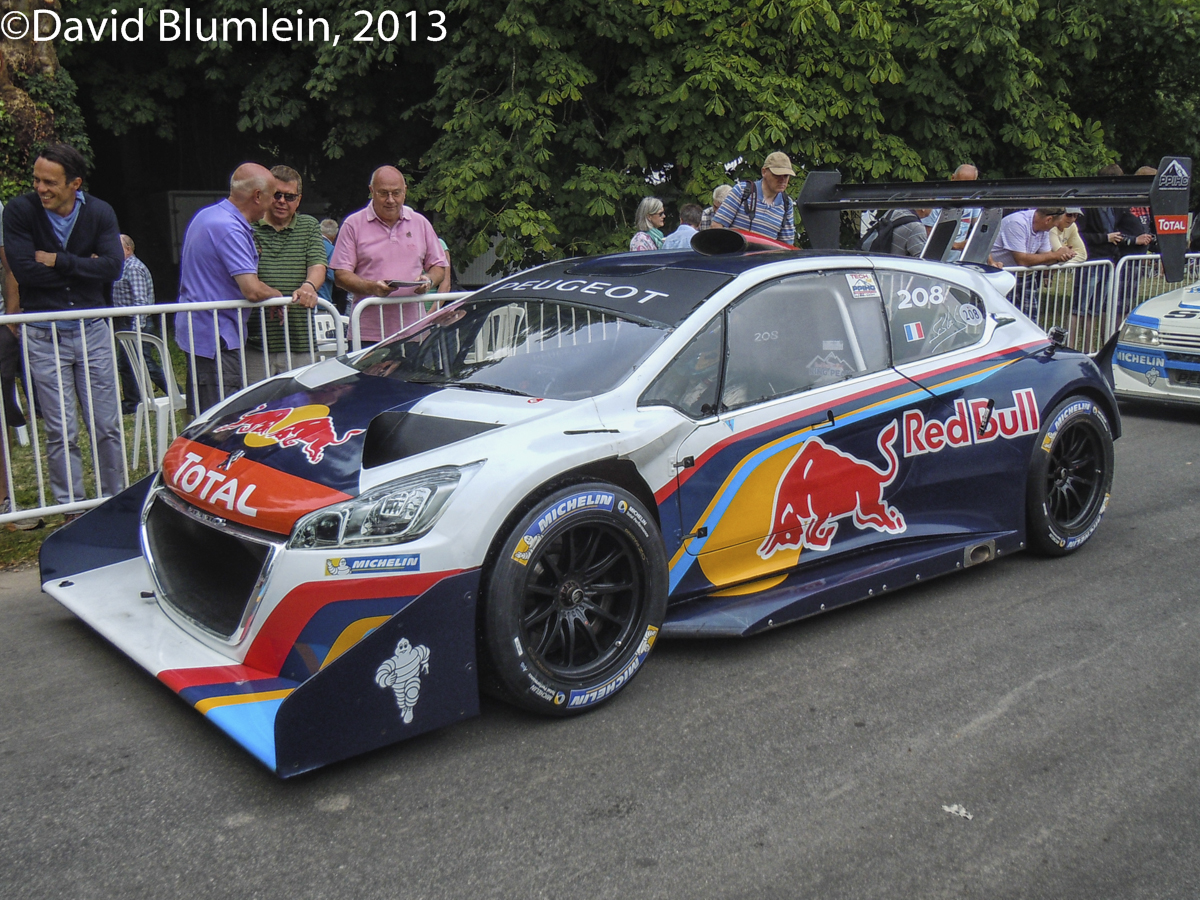
More record breaking – the Peugeot 208 T16 with which Sebastien Loeb lowered the record at the Pikes Peak Hill Climb by 90 seconds! This one–off machine puts out 875 b.h.p. via the four wheels and set a time of 8 mins 13.878 seconds on the 12.42 mile drive up through the 156 corners of this incredible venue in Colorado.
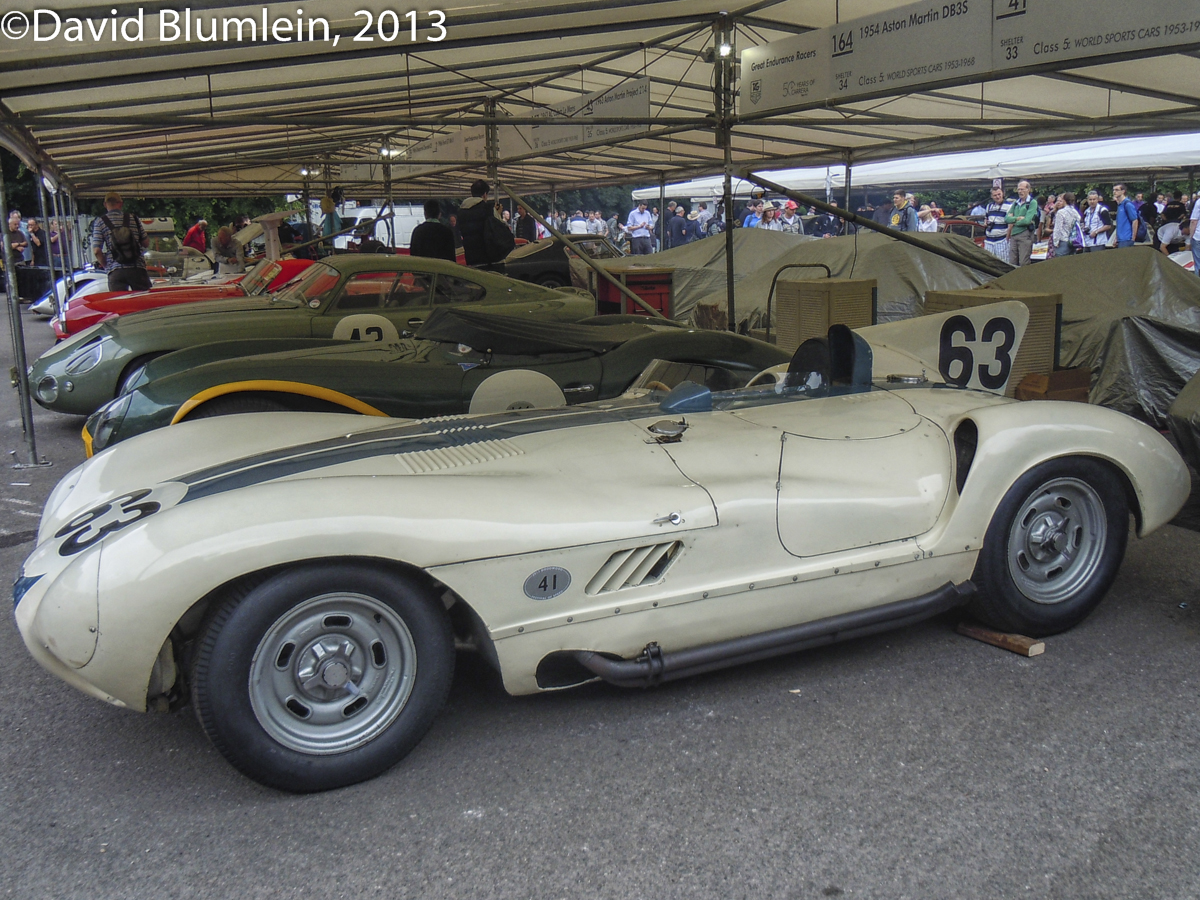
It is not often that the sole Cunningham C-6R escapes from its captivity at the magnificent Collier Collection in Florida. This attractive car, however, ranks as a failure. It is the last of the line of cars which Briggs Cunningham built to conquer Le Mans, a goal he never achieved to his great disappointment. It appeared for the 1955 season and differed from its V-8 predecessors in having an Offenhauser 4-cylinder engine more usually associated with Indianapolis than sports car racing. This unit was mounted inclined at 12˚ to the left and was de-stroked to 2942 c.c. The car first raced unpainted at the Sebring 12 Hours but had to retire when the flywheel exploded. By Le Mans it had acquired a fin and traditional American colours of white with a blue stripe. But the engine was not suited to the fuel supplied and its drivers Briggs Cunningham and Sherwood Johnston had to retire. The car raced again a few months later at Elkhart Lane where the Offenhauser failed once more. As Cunningham was by this time becoming involved with racing Jaguars, the C-6R finished its career with a Jaguar engine.
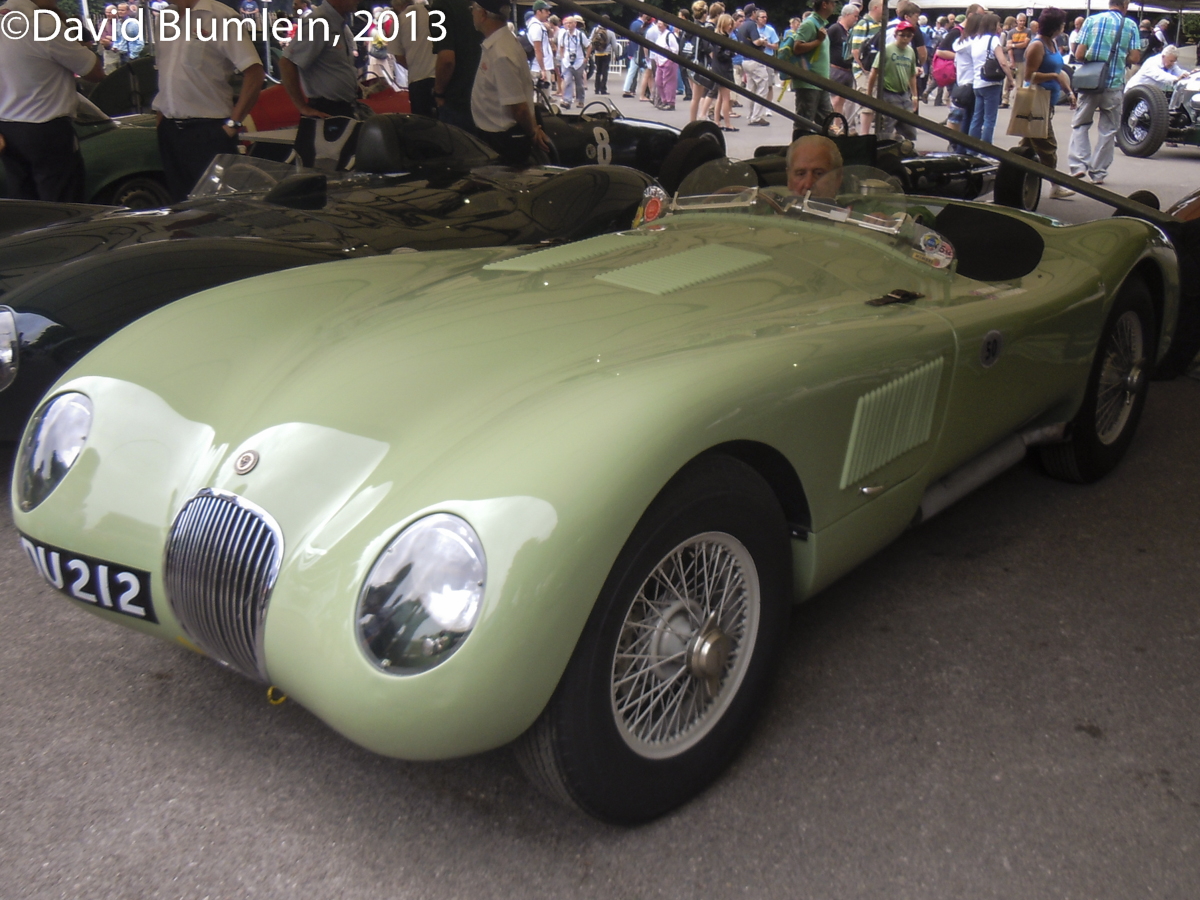
This is Jaguar C-Type chassis 005 and it has a special place in history. In 1952 Stirling Moss drove it to victory in the Reims Sports Car Race, thus making it the first car to win an international sports car race using disc brakes. Sitting at the wheel here is Norman Dewis who was Jaguar’s long-serving test and development driver. In fact, so precious was he to Jaguar that Sir William Lyons forbade him to race. In 1955, however, the boss relented twice: in that year’s Le Mans, Dewis shared the third long-nosed works D-type with Don Beauman who eventually put the car irretrievably into the sand when lying fourth. Then in the Goodwood 9-hour race Dewis drove Jack Broadhead’s D-type with Bob Berry into a respectable fifth place.
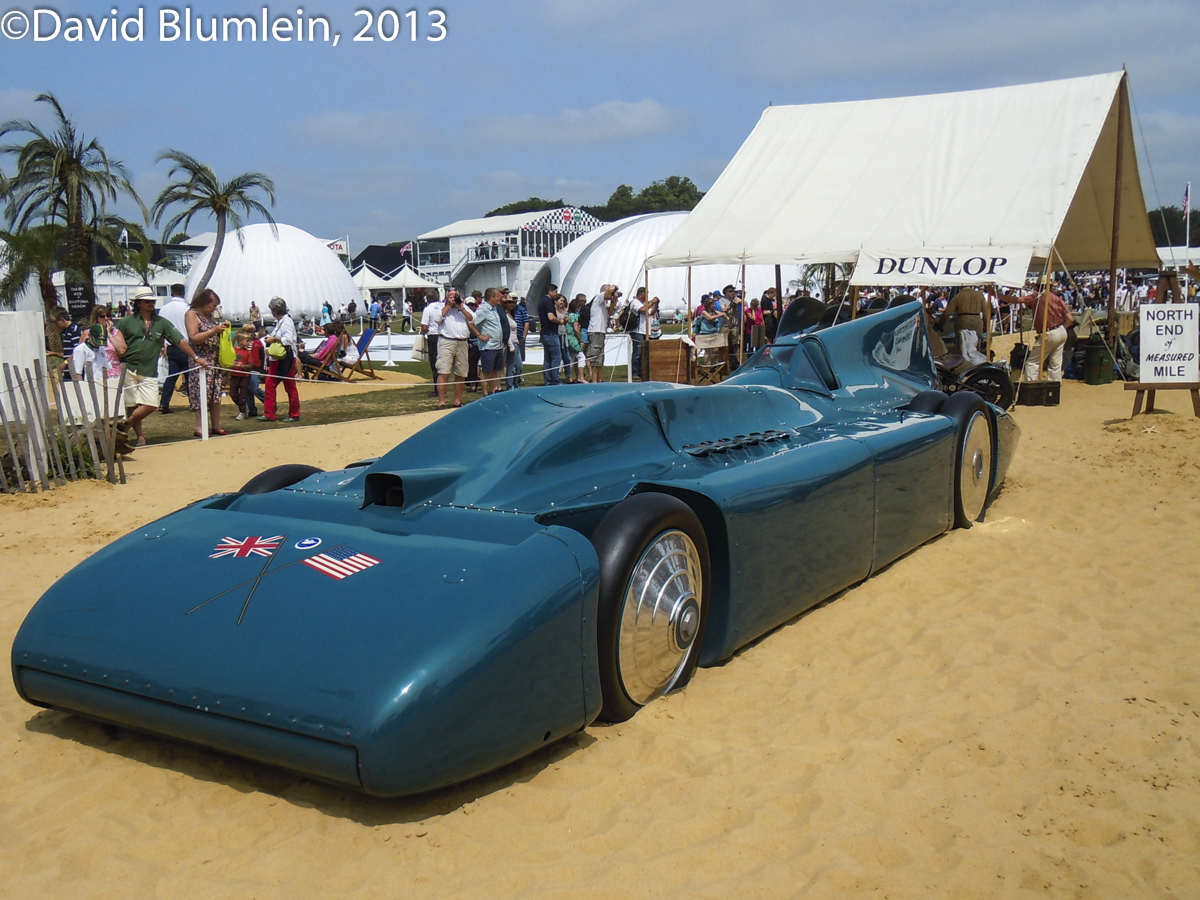
Over from the Daytona Speedway Museum was the final version of Sir Malcolm Campbell’s Land Speed Record car Bluebird. After a break in 1934 from record-breaking which gave Reid Railton time to come up with this all-enveloping body, Bluebird returned to Daytona in March 1935 when this 5-ton machine, complete with twin rear wheels and air-brakes and powered by a 36.5-litre supercharged Rolls-Royce R engine, took the record at 276 m.p.h. However, Daytona Beach was becoming increasingly unsuitable for these higher speeds and Campbell opted to try the salt flats at Bonneville in Utah – by September he had become the first man to drive a car at over 300 m.p.h., 301.129 m.p.h. in fact. Campbell had achieved what he wanted and retired from the arena.
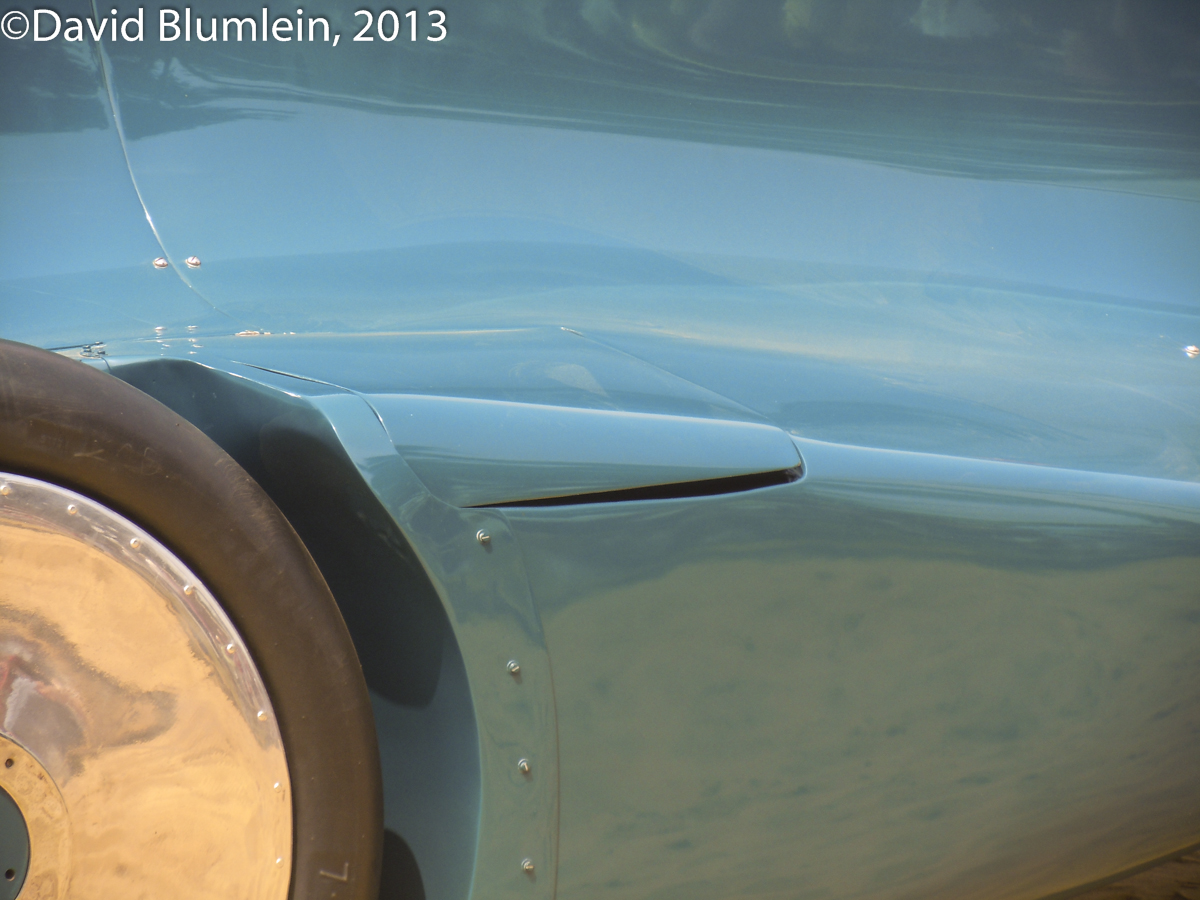
One of Bluebird’s air-brakes.
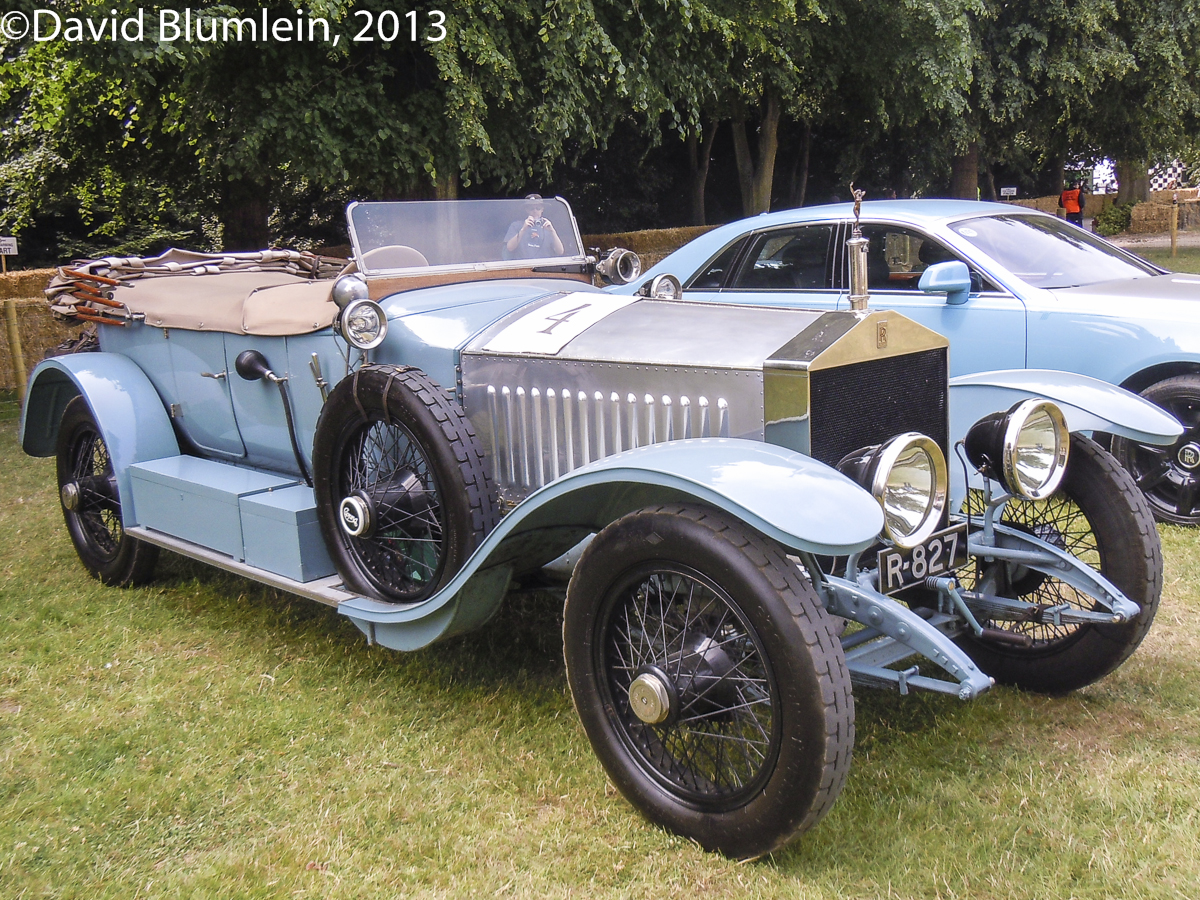
Tucked away from the general crowds on the southern fringes of Goodwood were two Rolls-Royces, unlabelled and without any apparent supervision. One was the 1913 Silver Ghost Alpine Eagle which James Radley used in support of the three works cars which brought success to the Derby marque in the Austrian Alpine Trial that year. Rolls-Royce had entered the cars to redeem their reputation after Mr Radley had driven his private Silver Ghost in the 1912 event and had failed to climb the Katschberg Pass because its 3-speed gearbox lacked a sufficiently low ratio. Needless to say, the 1913 cars had 4-speed boxes and other modifications:
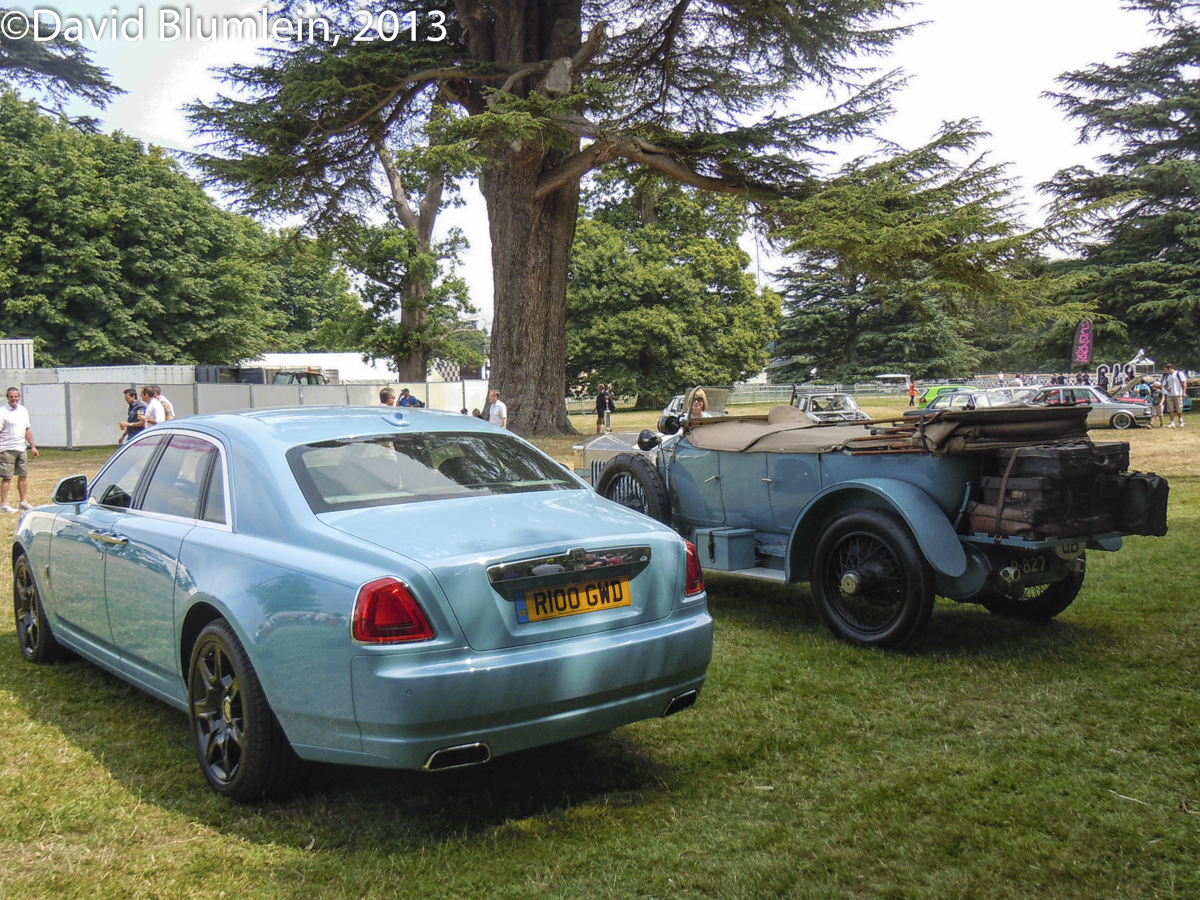
To recall their ultimate success, Rolls-Royce introduced the special edition “Alpine Trial Centenary Collection” version of the current Ghost model painted a pale blue and here can be seen the two cars from the rear.
David Blumlein, August 2013
Not what you want to see in the viewfinder at Radillon, Alex Buncombe is a passenger as the GT-R heads towards the wall…………and me……………still it gave the commentators something to laugh at,
http://www.youtube.com/watch?v=oo_aGVtqRgg&feature=youtu.be
always pleased to be of service! And yes I ducked………….
John Brooks, July 2013
Our Special Correspondent was at the 90th Anniversary Le Mans 24 Hours. He shares with us a different but important historical perspective on the world’s greatest motor race.
The week leading up to the Le Mans 24 Hour race is always rewarding for a motor car enthusiast. This year marked 90 years since the first running of the race in 1923 and on the Tuesday there was a special celebration of the old Pontlieue Hairpin – the original circuit ran deep into the southern suburbs of the city, doubling back at a tight hairpin in Pontlieue, a favourite spot for those early photographers as the cars were travelling comparatively slowly.
The roads still exist although the more distant approach sections are unrecognisable today as they have to cross the ring road. The corner was suitably adorned with signs of the time:
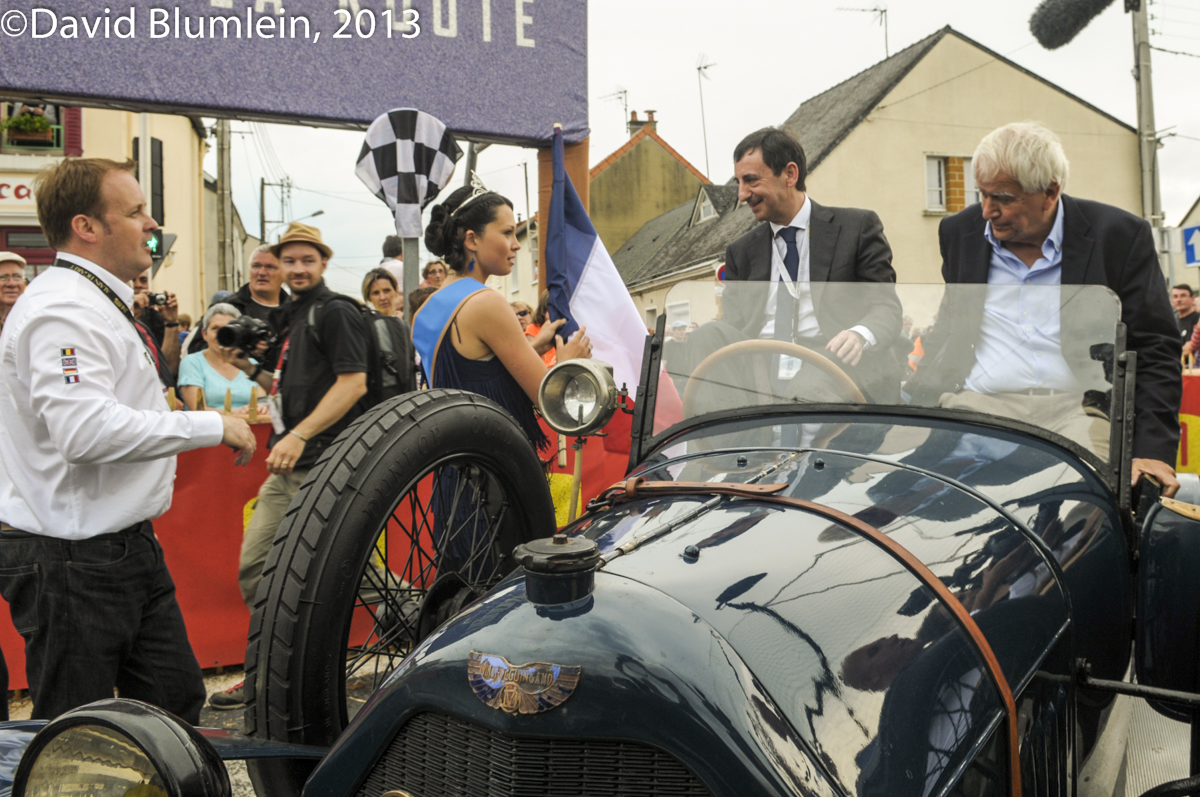
The President of the A.C.O. Pierre Fillon unveiled the traditional sign marking the corner, having arrived in a contemporary (and boiling!) Vinot-Deguingand, a French marque which took part in the very first race.
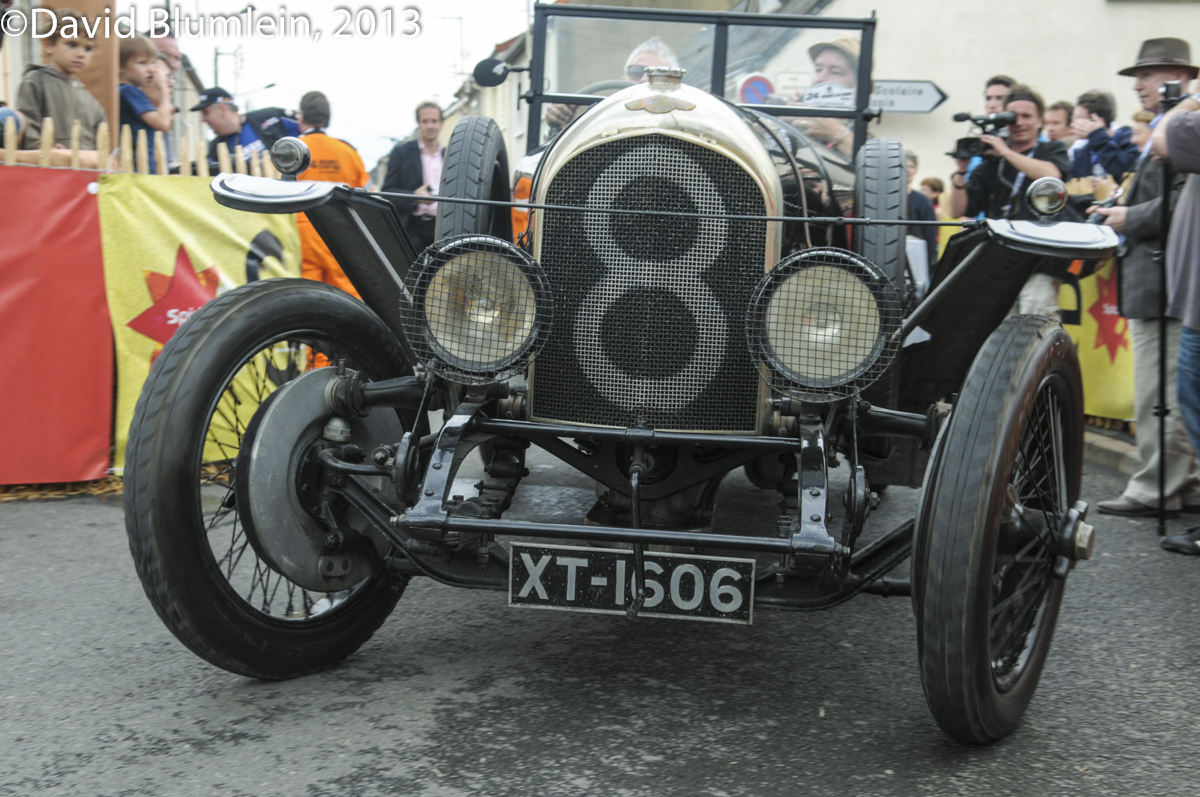
The 1924 –winning Bentley also did some runs. The corner was foreshortened for 1929-31 by which time the A.C.O. had purchased the land between the start/finish area and Tertre Rouge. Here they opened in 1932 the section of track which still comprises the Esses, and Pontlieue fell into disuse from then onwards.
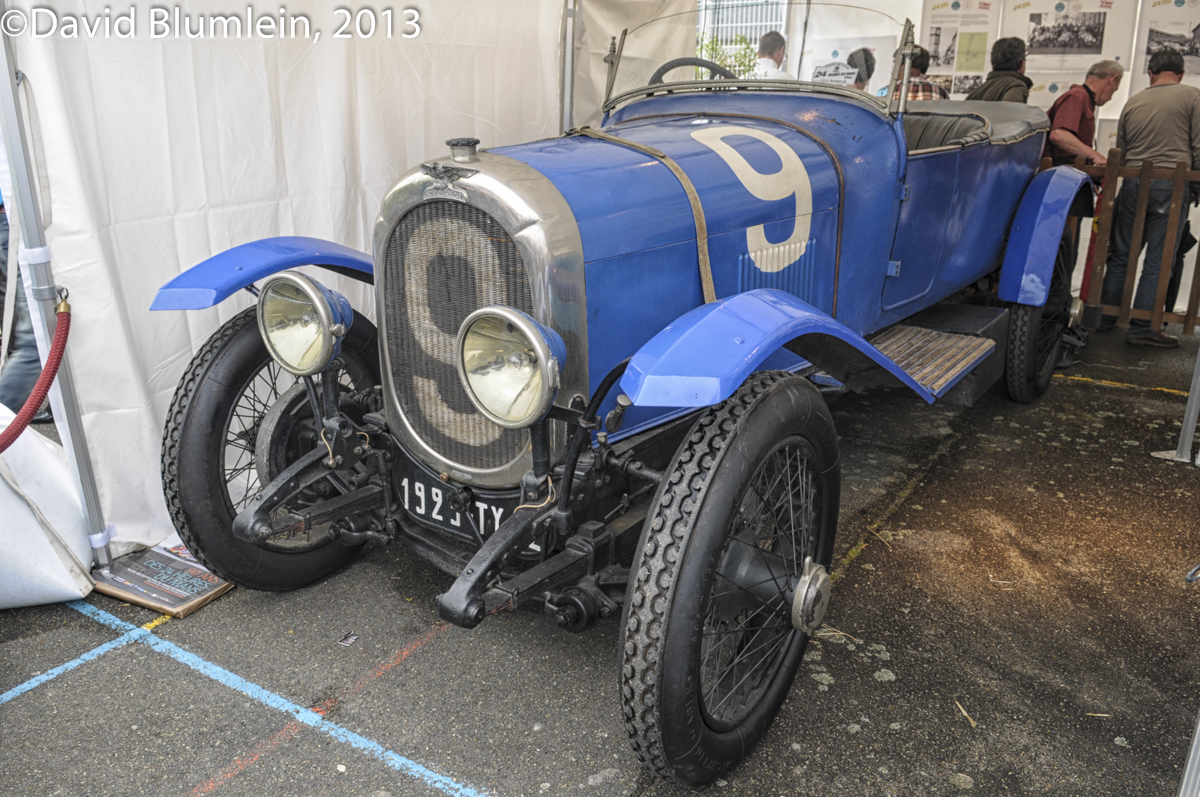
Present at the ceremony was the 1923-winning 3-litre Chenard et Walcker.
Chenard et Walcker (not to be confused with another French marque, Chenard, the cars of Louis Chenard one of which ran at Le Mans in 1924) was in the mid-Twenties France’s fourth largest car manufacturer, turning out some 100 cars a day in its factory at Gennevilliers in Paris. Not only did it take the first two places with its o.h.c. 3-litres in the first race in 1923, but a smaller-engined version won the 2-litre class in 1924.
The company is also remembered for the exciting little Henri Toutée-designed 1100 c.c. “tanks” which had widespread success in sports car races in 1925/26. Two such cars, one with a larger engine, ran as private entries at Le Mans as late as 1937, albeit with no success.
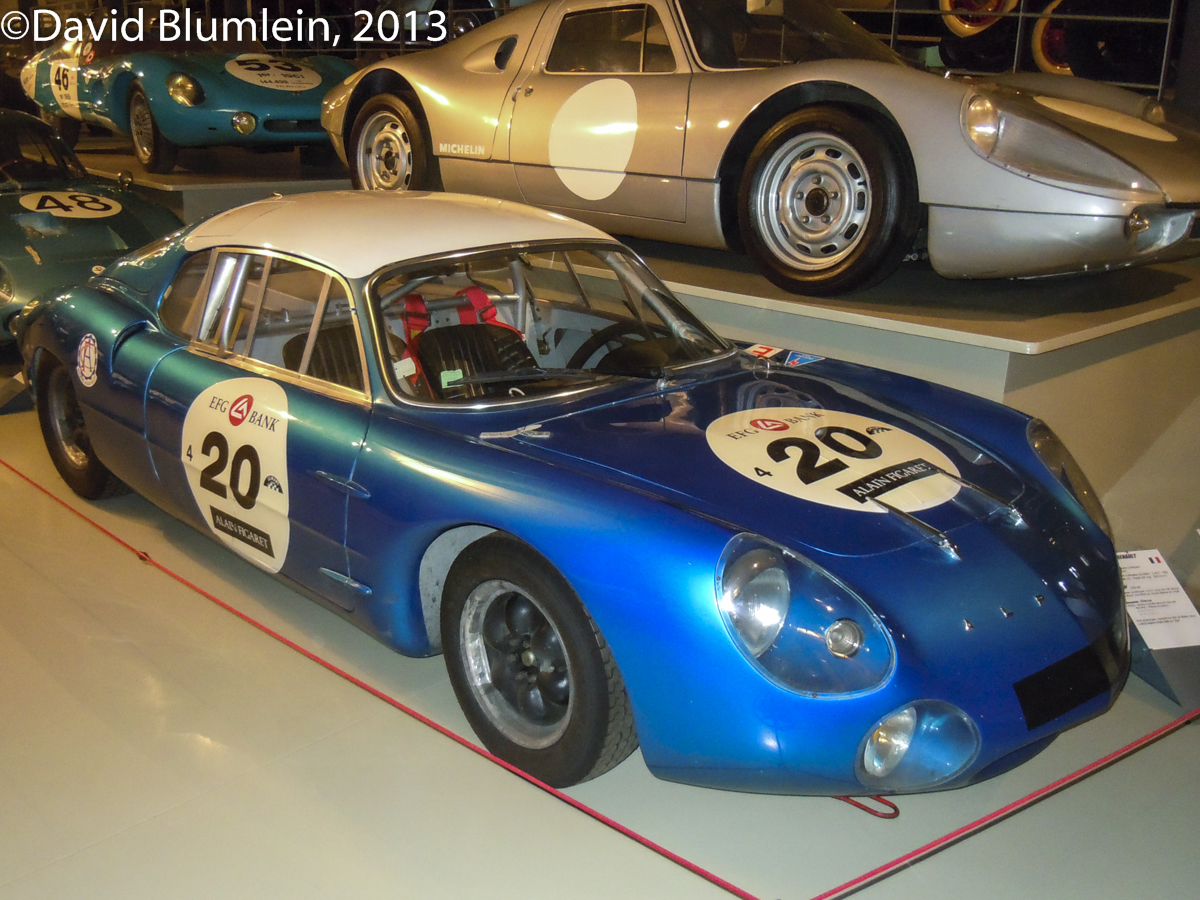
The museum at the circuit can always be relied upon to vary the exhibits and some recently loaned cars are worthy of mention. This year sees a serious revival of the Alpine marque with Renault not only developing a new production Alpine sports car (in collaboration with Caterham) but also adapting an Oreca 03 LMP2 car to run in the 24 Hour race as an Alpine A450. It was, of course, 50 years ago that Jean Rédélé’s company made its first venture into endurance sports car racing with the M63 coupés; there is one currently on show in the museum.
Their first attempt at Le Mans was unfortunately shadowed in tragedy – one of the Project 214 Aston Martins dropped all its oil on the Mulsanne Straight on the Saturday evening causing a number of cars to crash seriously, one of which was the M63 of the young Brazilian Alpine agent, Christian “Bino” Heins. His car flew off the circuit, struck a telegraph pole and exploded in flames, giving the poor driver no chance of survival. Despite this setback, the Alpine cars went on from 1964 to score manifold victories in endurance races in the smaller categories, especially with their A210 coupés.
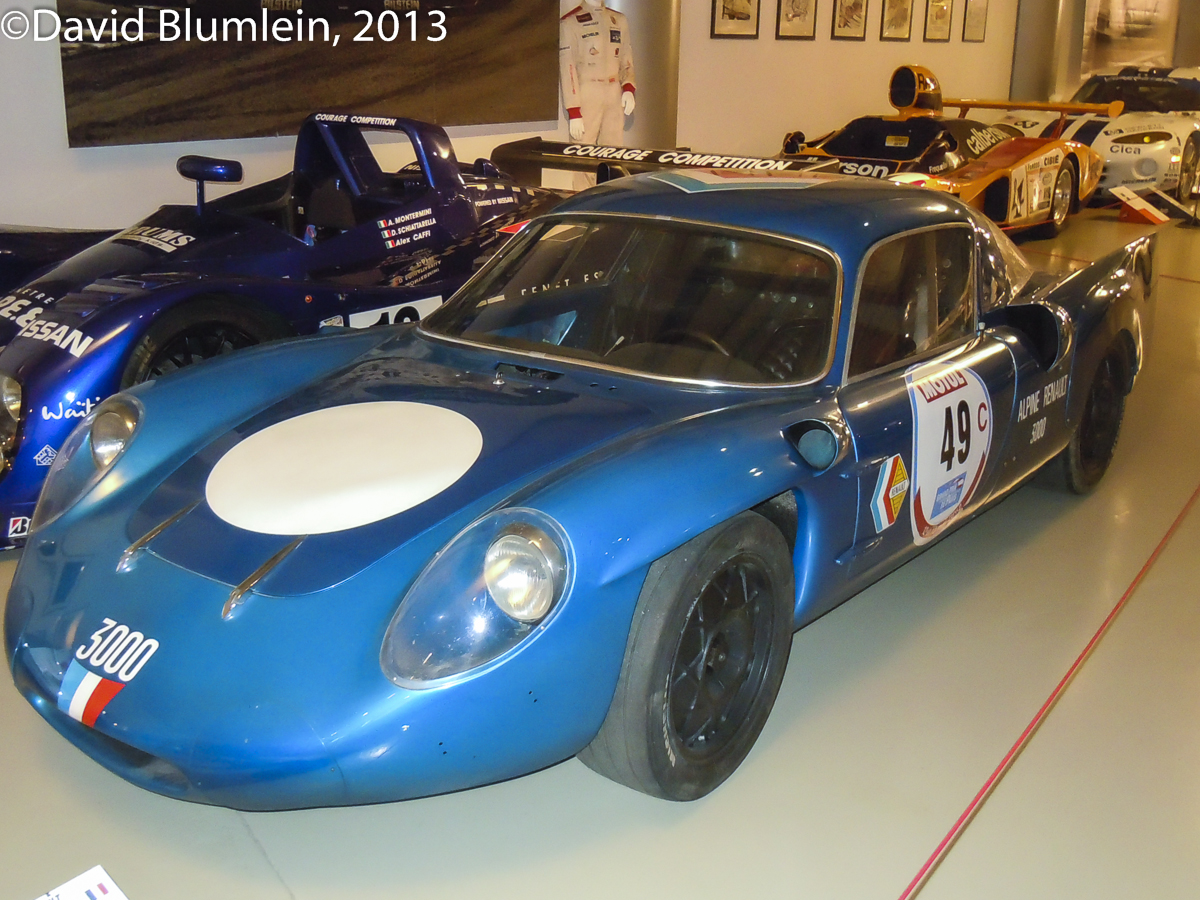
With a 3-litre limit slapped on prototypes from 1968, Alpine saw the opportunity to go for outright wins and Gordini developed a V-8 engine for them. This was initially tried out in an A210 coupé, this one-off prototype being re-named the A211.
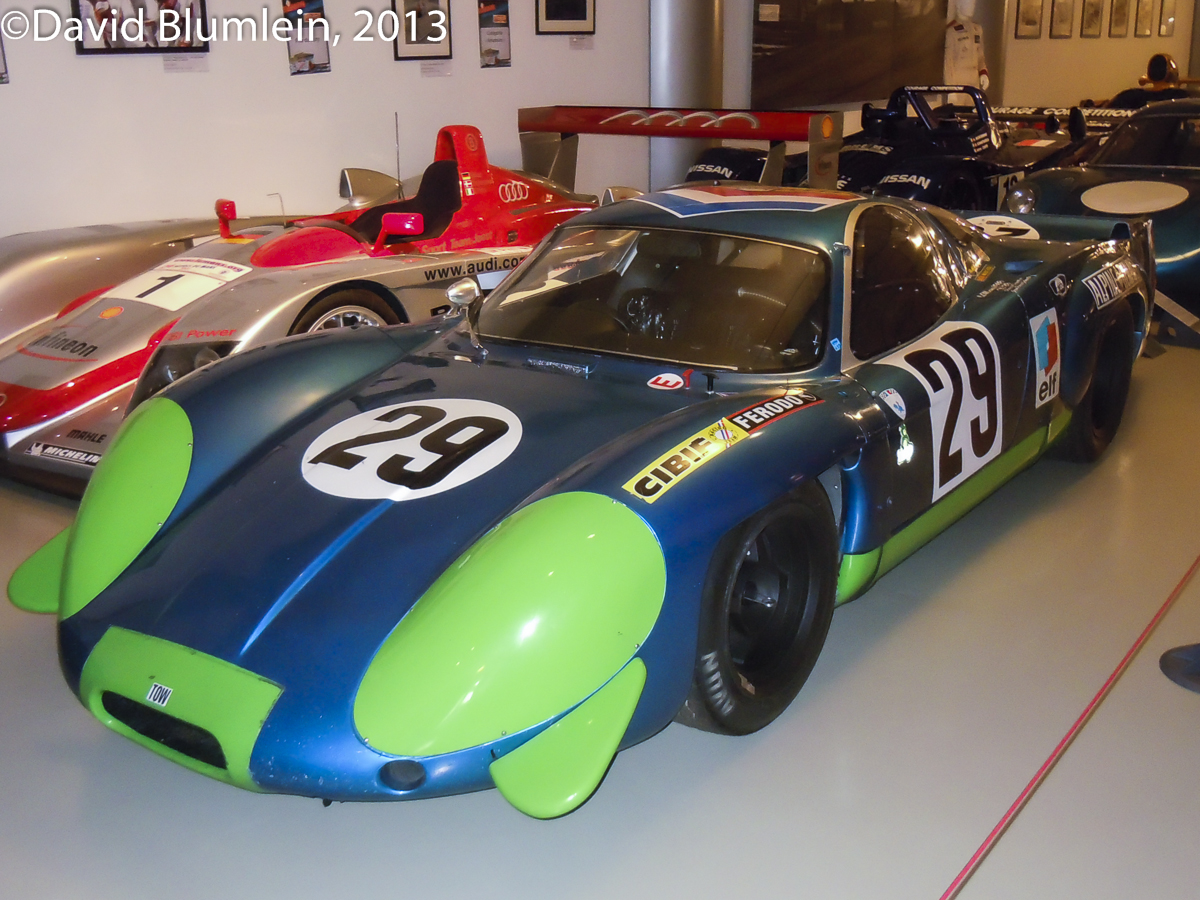
The car was raced briefly and came to Le Mans for the Test Day, but it was clear that the engine was too powerful for the chassis and the all-new A220 was designed.
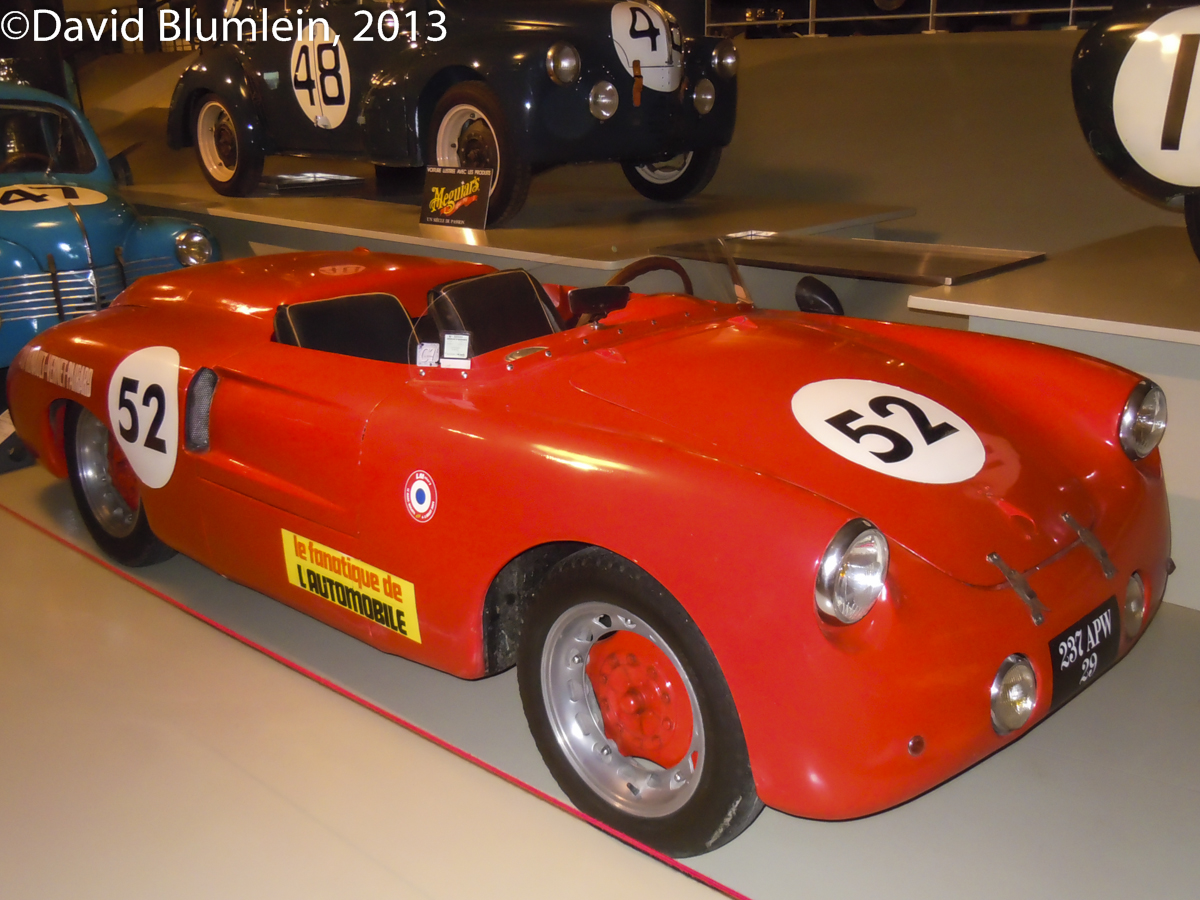
This is a V.P., a Verney-Pairard, the work of two enthusiasts, Just Emile Verney who had driven in every Le Mans race from 1931, and Jean Pairard, a Parisian industrialist. They were keen to create a not-too-expensive sporting car with a view to gaining the support of the Regie Renault for small series production. One of Pairard’s engineers, Roger Mauger, drew up a tubular chassis with all-round coil spring independent suspension and a Renault 4cv engine at the rear, the whole bodied by the French coachbuilder Antem. They took their first car to Montlhéry for some trial runs and the performance caught the eye of Franςois Landon, head of the Regie’s Competition Department. He recommended that they try for records and the car, duly adjusted aerodynamically with full wheel spats, ran in October 1952 at Montlhéry, taking eight International Class H records. The Paris Salon was just opening and Renault took over the car, giving it pride of place on their stand and re-naming it a Renault R1064!
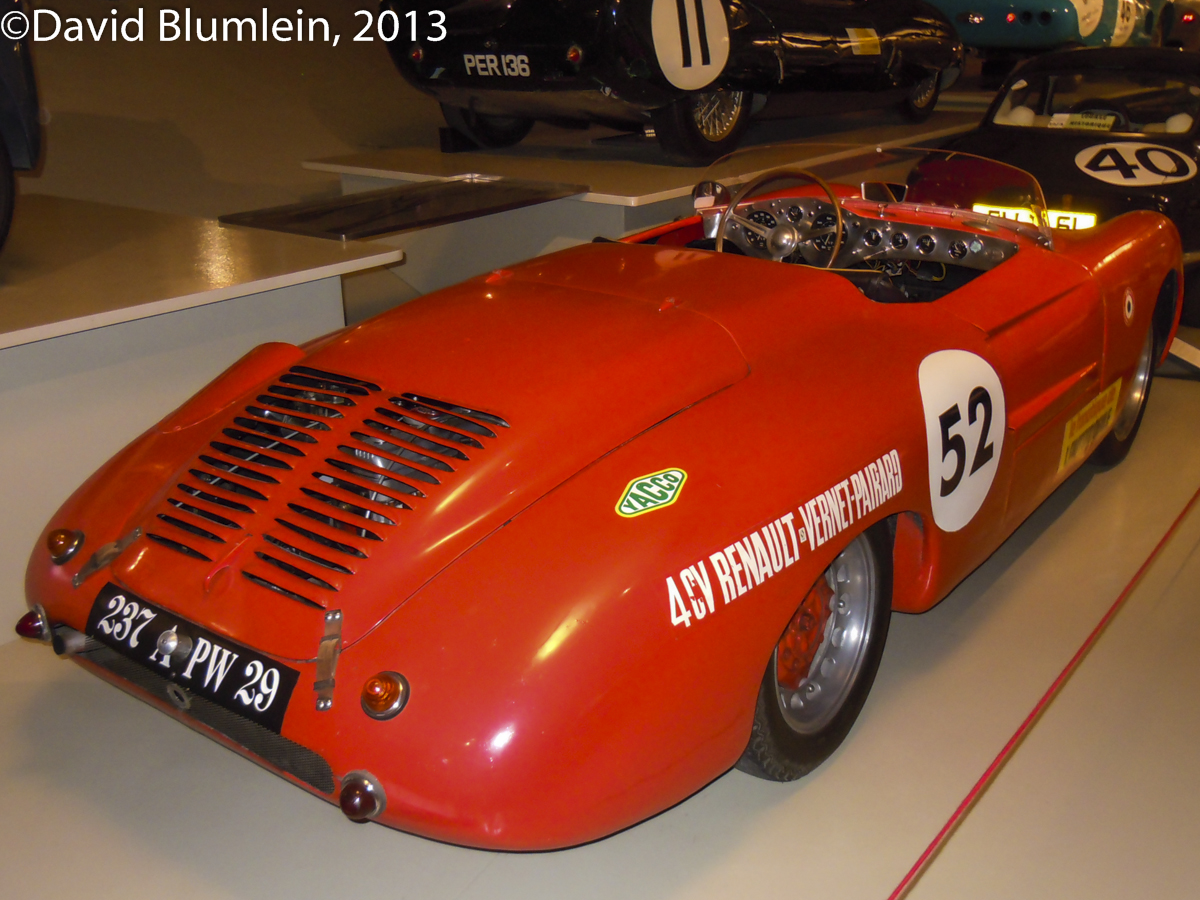
This car ran with the necessary lights etc. at Le Mans in 1953 along with a new coupé V.P. which had an oversize cockpit roof to accommodate the corpulent Pairard! The “Renault R1064” retired in the seventh hour while the little coupé, much handicapped by its excessive frontal area, finished last. No long-term support for V.P. was forthcoming from Renault and the R1064 reverted to being a V.P. once more! It then received revised bodywork for 1954 when it returned to the 24 Hour race.
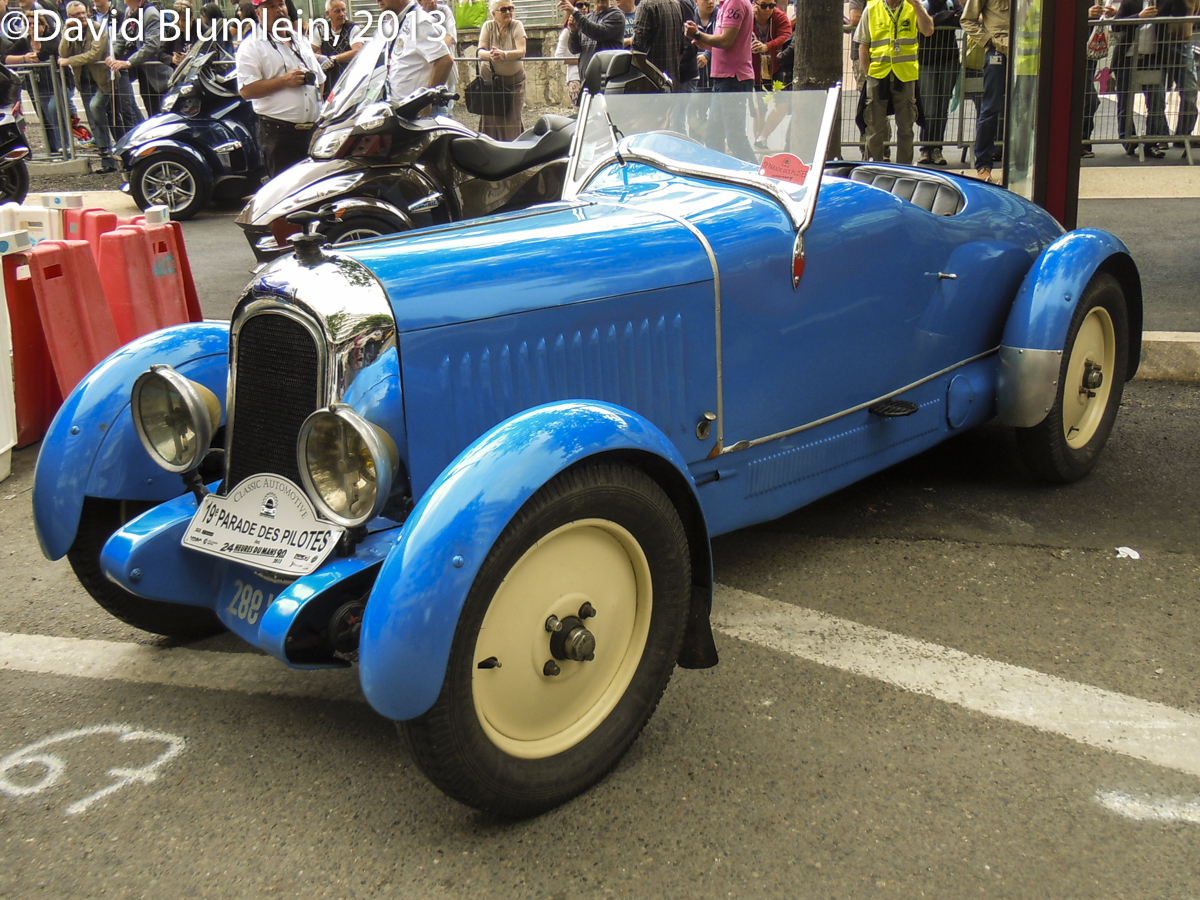
At the Drivers’ Parade, mercifully dry until the very end, it’s back to Chenard et Walckers. The real gem was this Torpille seen above.
At the 1927 Paris Salon Chenard et Walcker introduced two 1500 c.c. sports cars: one was a production version of their little “tank”, the Y8, and the other a more conventional model with cycle wings, this Torpille, the Y7. The latter was sold in “bleu France” as seen here, and both models were used in national competitions by private owners – no more works cars from the Gennevilliers company.
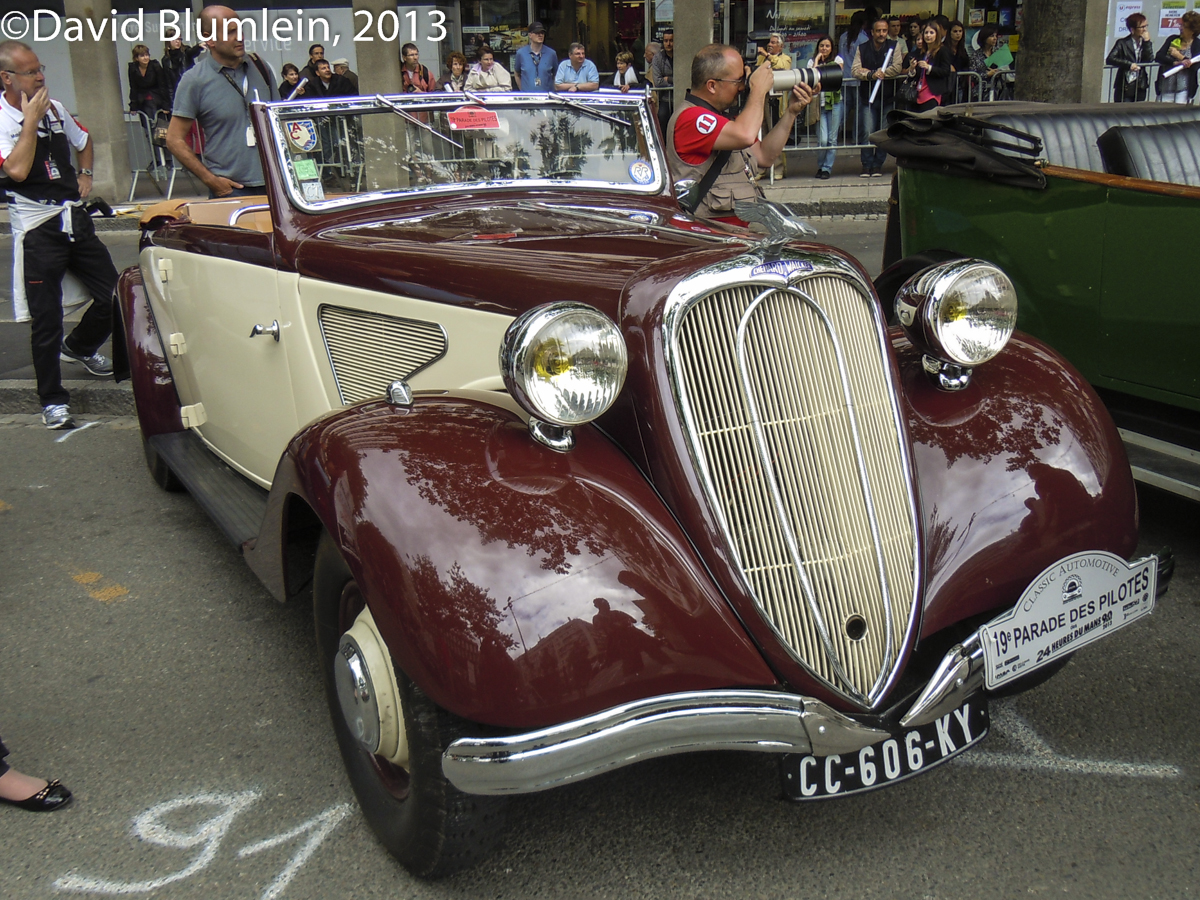
In the Thirties they made some technically interesting models such as this Super Aigle 24. Their Super Aigle range adopted front-wheel drive at the 1934 Paris Salon when Citroën more famously did the same, and they also used torsion bar independent suspension. This Super Aigle 24 dates from 1936 and has a Cotal electromagnetic gearbox. Alas, these advanced features did little to save the company which was taken over by Chausson who substituted Ford and Citroën engines. By the early post-war period the Chenard et Walcker name was on a forward-control 2-cylinder van soon to be Peugeot-powered and then Peugeot produced.
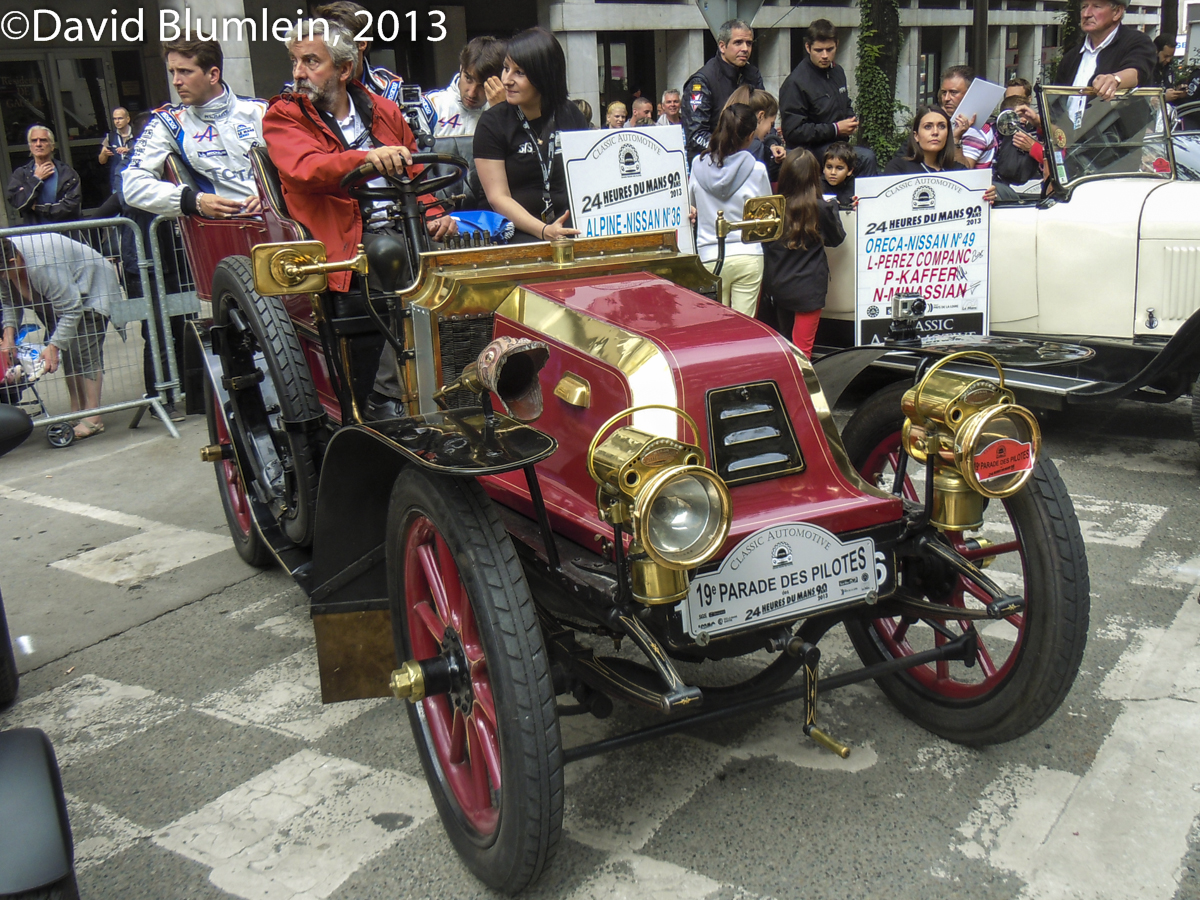
Perhaps it was appropriate that this year’s Alpine drivers should have been chauffeured in a Renault – a 1904 3.7-litre 4-cylinder Type U model.
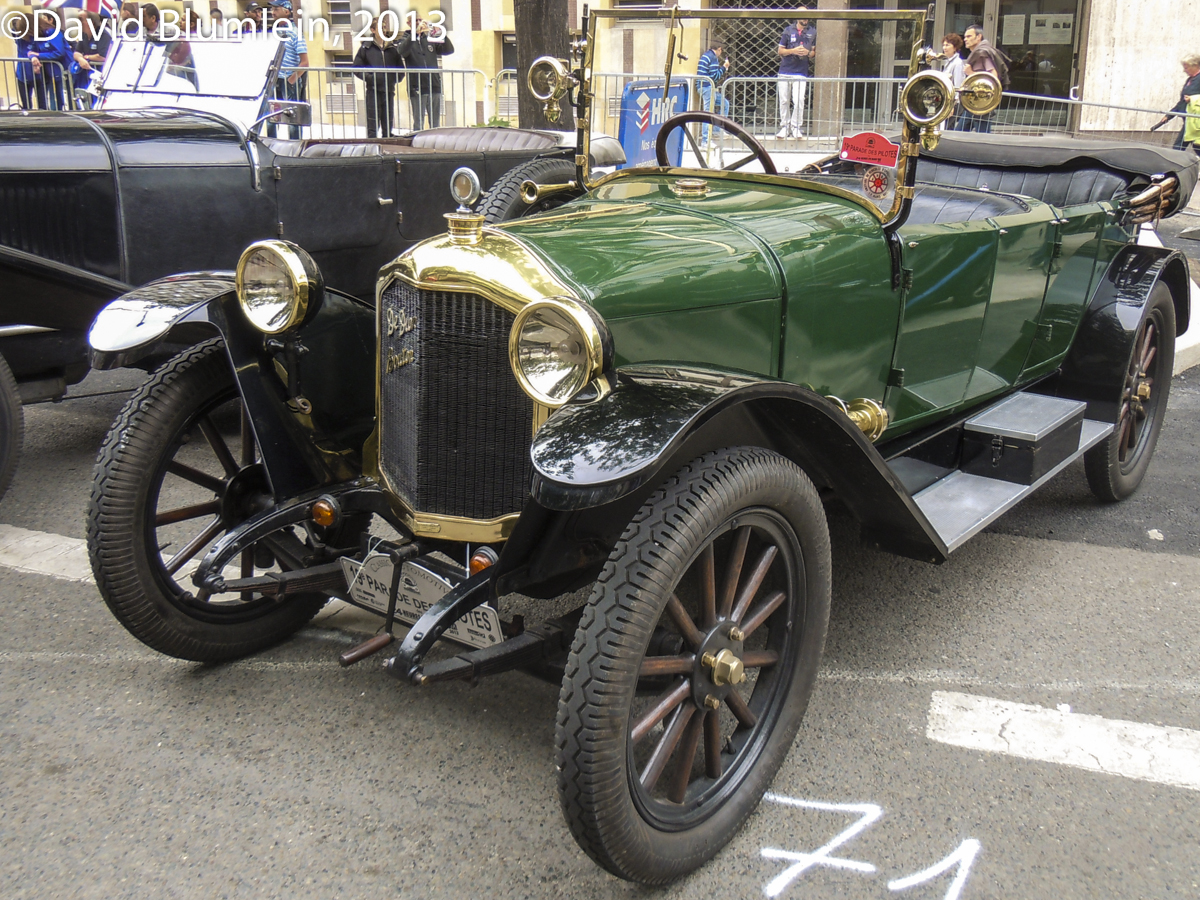
There are always representatives of the pioneering De Dion Bouton company in the parade. Here we see an example of their popular ID model, dating from 1919. It is interesting to note that the company gave up using their famous De Dion rear axle as early as 1911/12 yet it is still used on today’s little Smart!
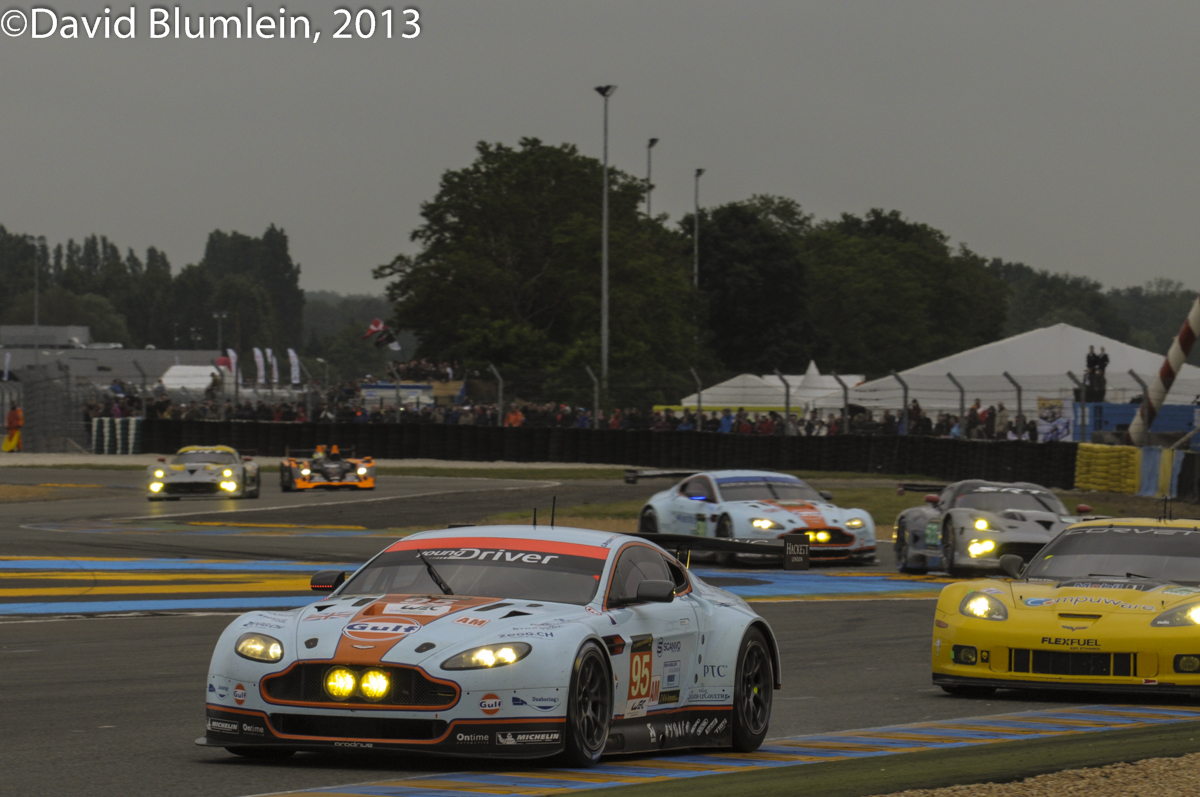
And so to the race. First, a small tribute to Allan Simonsen, by all accounts a lovely person and a highly-rated driver who tragically lost his life on just his third lap of the race. Here he is completing his second lap and starting his third fateful one just moments before disaster struck.
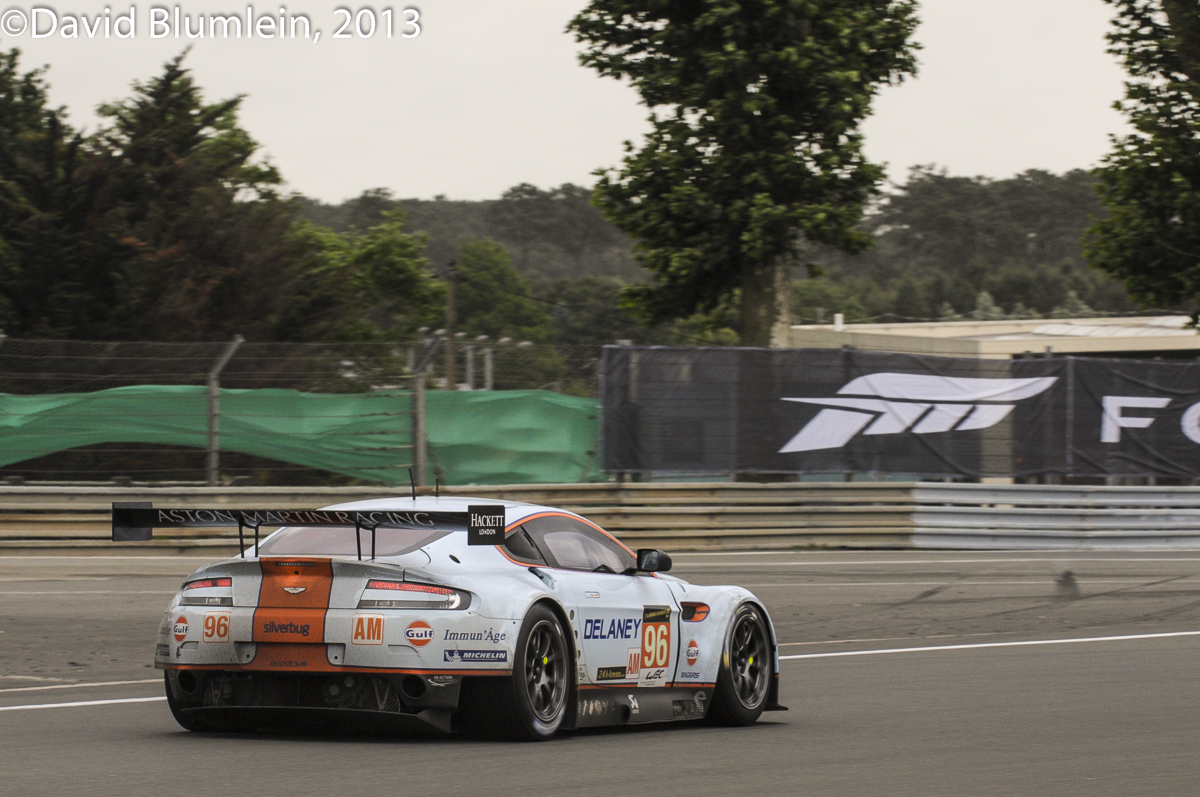
And here is his class team-mate passing the tragic spot at Tertre Rouge where the public road joins the private section of track. At the specific request of Simonsen’s family the Aston Martin team carried on racing.
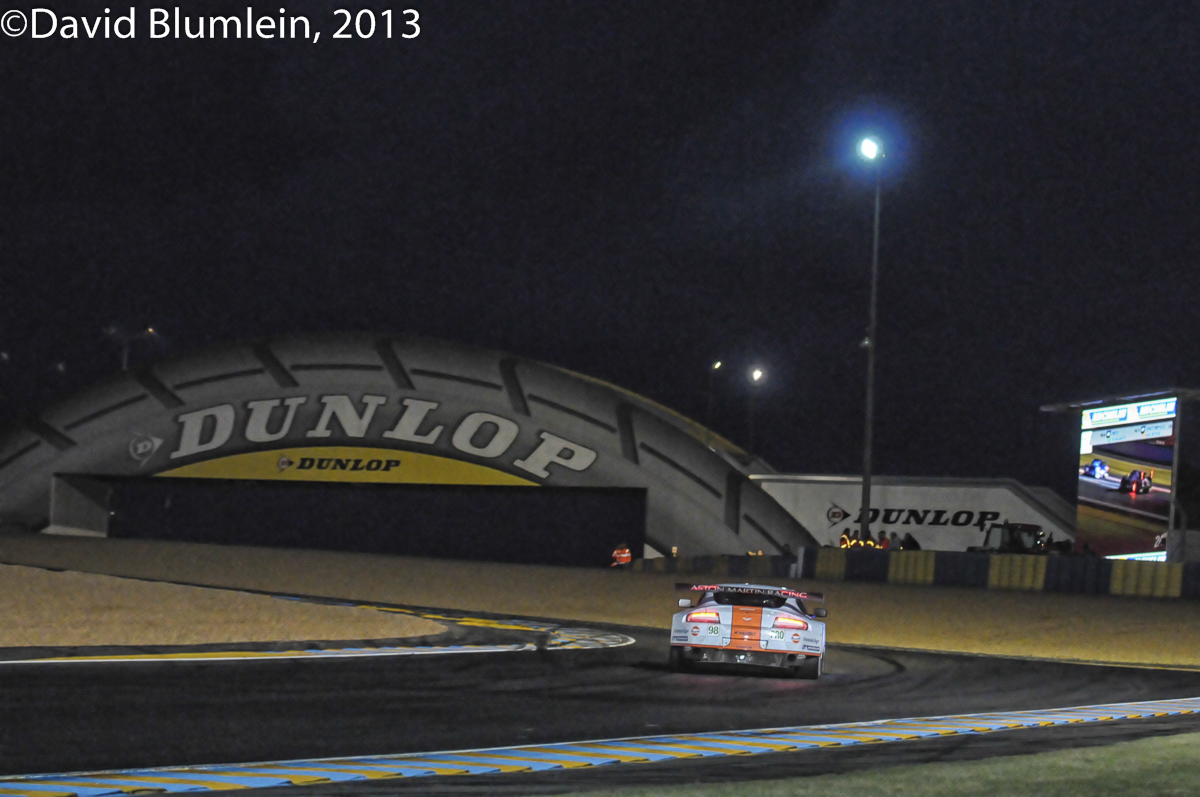
Looking back at that first race ninety years ago, it is interesting to reflect on one or two similarities with today. In 1923 the organisers used army searchlights to illuminate the corners – here is the Dunlop Chicane illuminated using more modern technology:
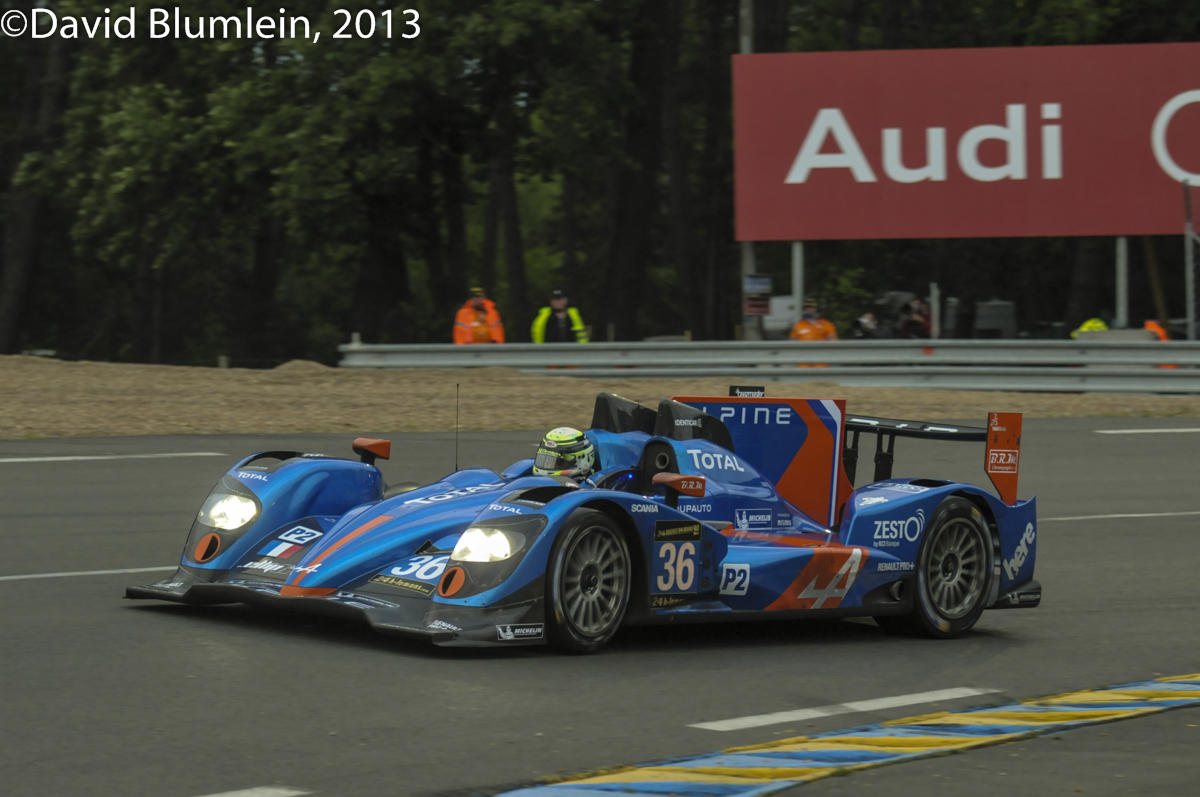
And the public road leading to the Arnage corner is still basically as it was –
the left-hander at Indianapolis then the short straight to the right-hand bend.
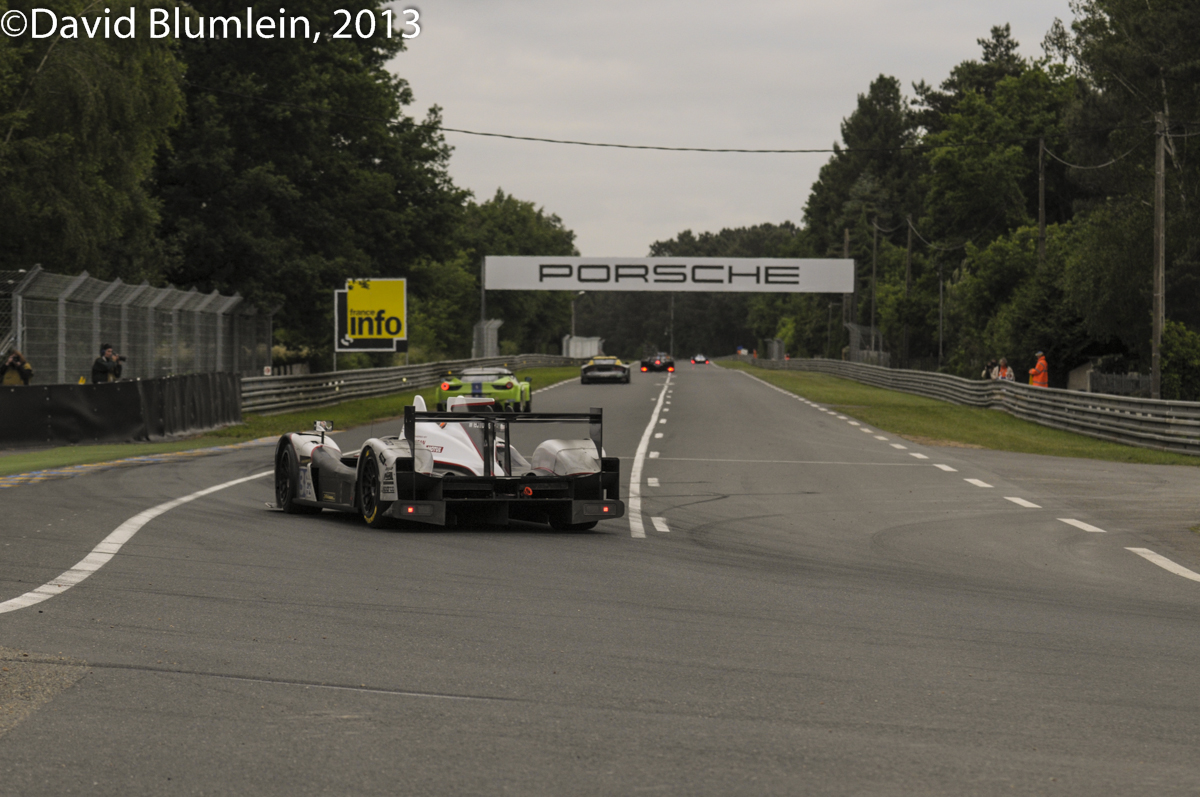
And here is the road out of Arnage looking up towards what are now the Porsche Curves but used to lead to the Whitehouse Corner – that road is still there.
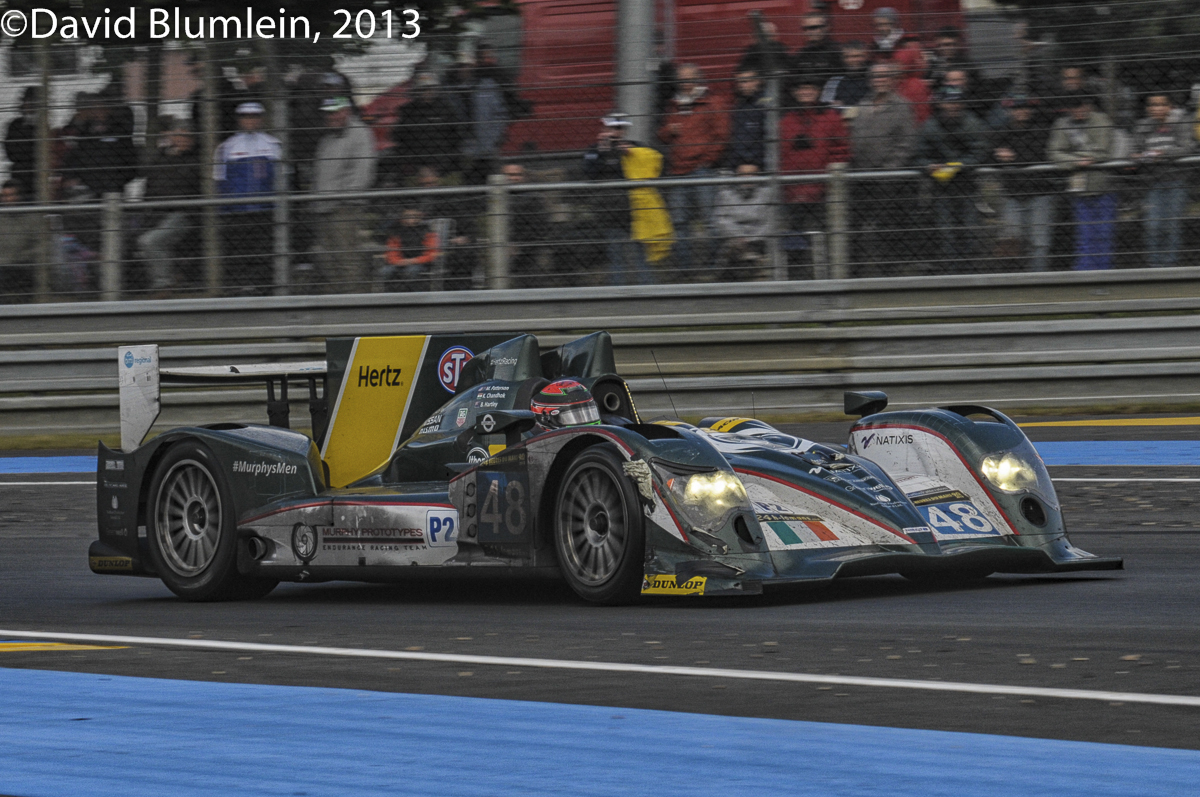
The gruelling nature of this race is reflected in the general state of some of the cars by Sunday. Here is the Murphy Team’s Oreca 03 looking distinctly grubby.
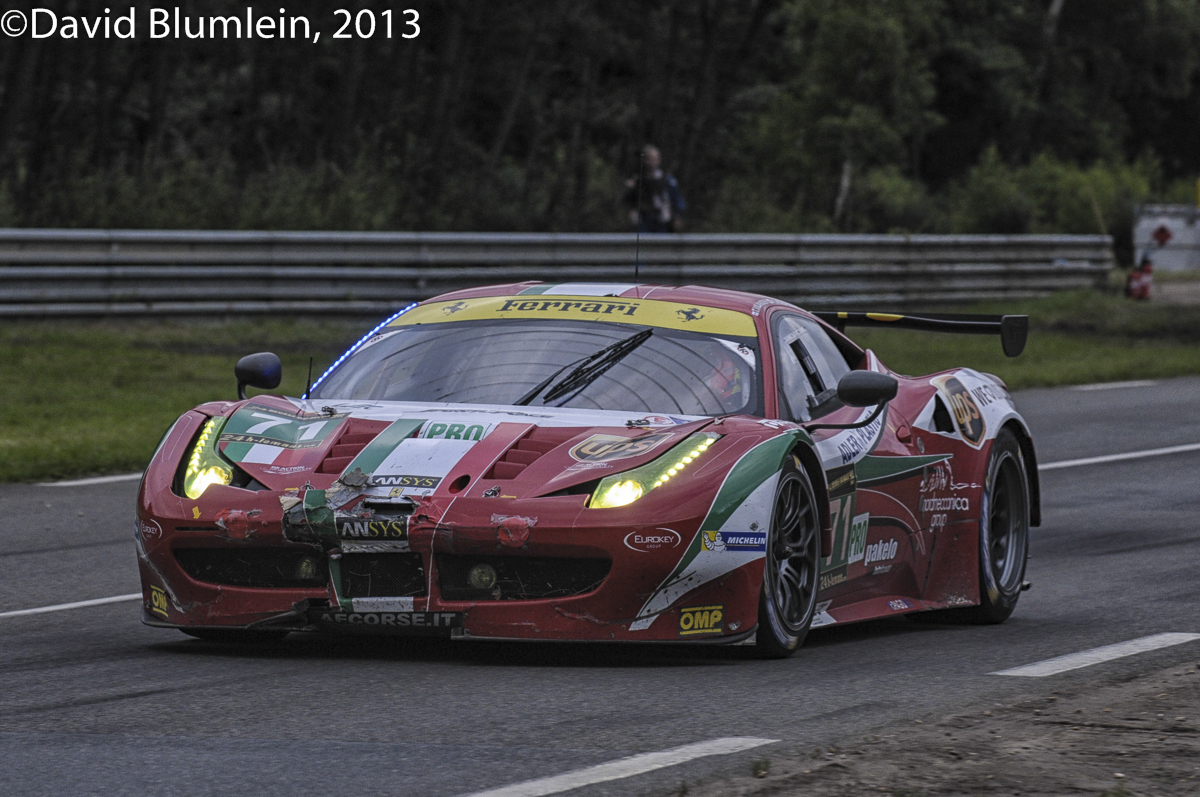
And two AF Corse Ferraris which have seen some battle, this was #71
And #51 was not much better
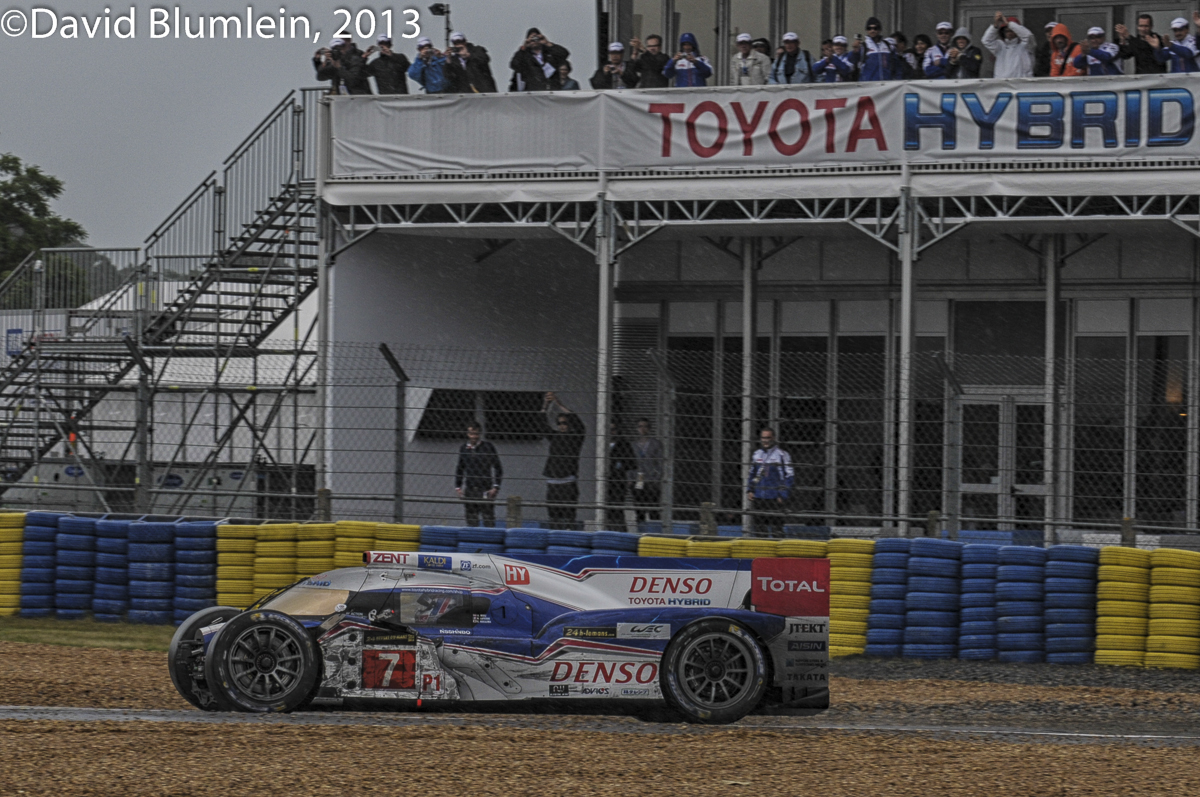
The sudden rain showers can catch out the best.
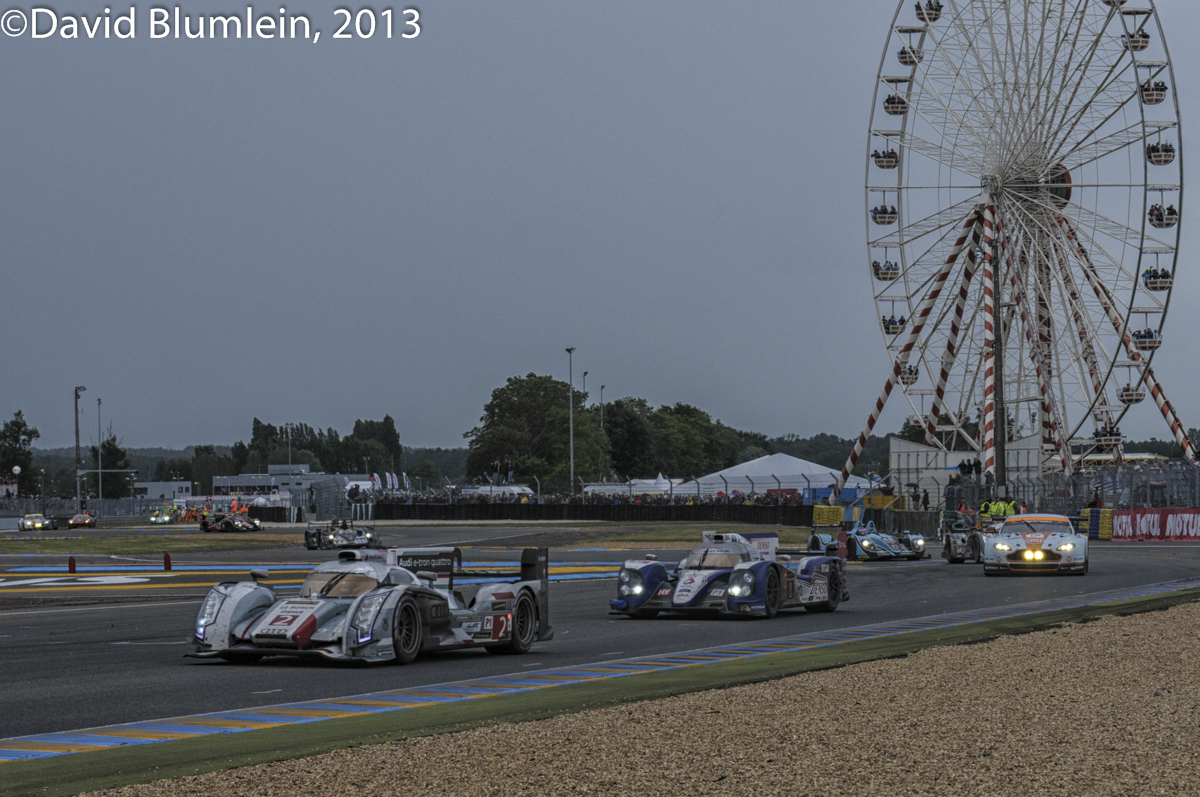
But to cross the line after 24 hours is worth all the effort:
David Blumlein July 2013
The Goodwood Festival of Speed was the usual cornucopia of all things automotive – something for everyone……………..so enjoy the scene. And like England’s cricketers, this post sees the 300 up for us in this first innings.
One of the great successes in recent endurance racing is the Blancpain Endurance Series. Stéphane Ratel has come up with a formula for GT3 cars that has a widespread appeal. As the jewel in the crown, the Spa 24 Hours, approaches, it seems appropriate to get the thoughts and reflections from our Special Correspondent.
An impressive 57 GT cars started the Blancpain Silverstone race, a week after the British GT series managed a splendid 46 starters for their “500” event. GT racing is certainly popular, but despite these successes, I pose the question: are there now too many GT races? On the very day of the Blancpain race, the British Endurance Series (Britcar) could only muster 8 starters for their Rockingham round and the GT Cup race at Brands Hatch had just 11 runners. These are series that have mustered healthy grids in the past, so is it all being overdone? It would seem to suggest so and this is a shame. Inevitably a consequence is an over-crowded calendar, of course. Much as we like them, fewer races, please, so that enthusiasts can attend more.
An unexpected and most welcome feature of Silverstone’s Blancpain round was the last-minute entry of a works Aston Martin, their V12 Vantage GT3. The car had been brought from the Nϋrburgring 24 Hours, given a quick work-out at Snetterton to adapt to the Pirelli tyres and taken thence to Silverstone.
That this car dominated the event was especially appropriate in Aston Martin’s Centenary year and it mirrors the appearance 60 years ago almost to the week of a single works Aston Martin winning the sports car race at Charterhall when Reg Parnell gave the DB3S its début (no GTs then!). The addition of the GT3 car to the regular Blancpain entry was very desirable – it makes the race more memorable and it breaks up the “package” concept whereby the same cars are expected at every round, so worryingly reminiscent of the unhealthily rigid situation in Formula One. Motor racing needs plenty of “natural” variety, with cars turning up when they’re ready, not because some selfish rules (motivated by greed) dictate that everyone has to come every time. Well done, Aston Martin, for coming when it suited your needs!
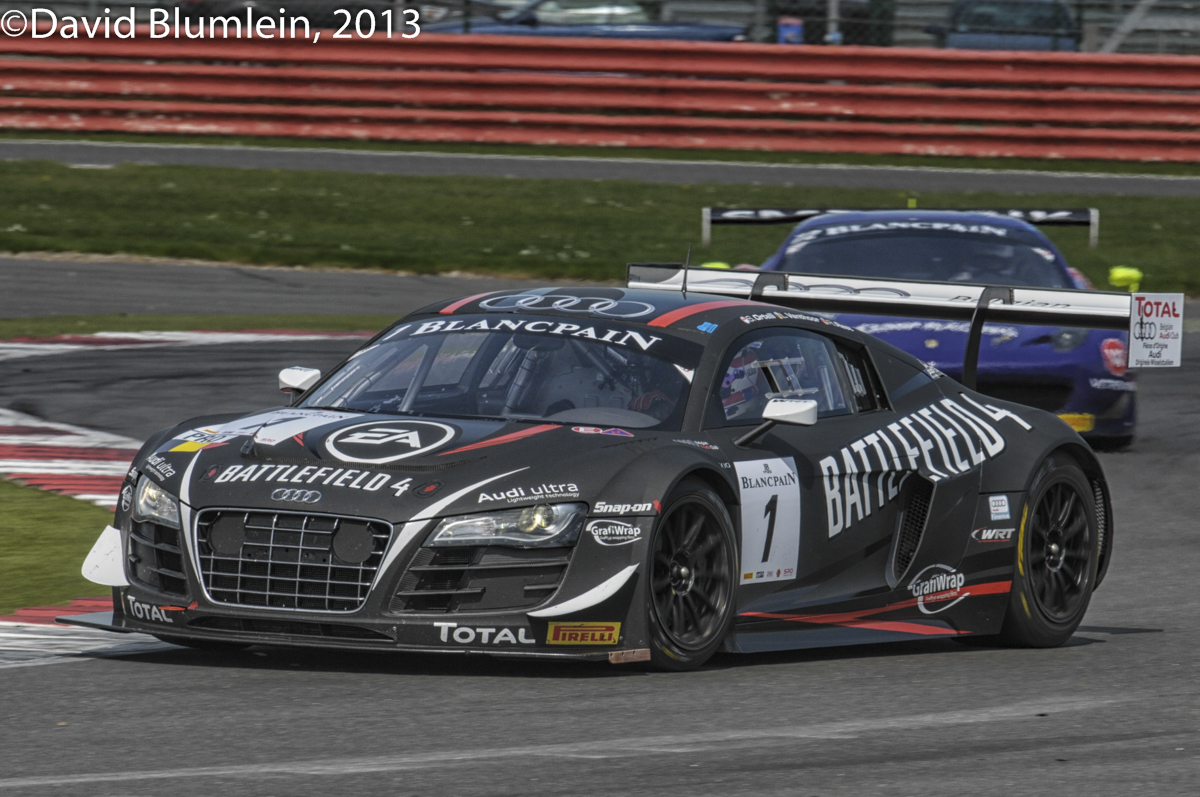
The Audi R8 has gradually been coming good, winning the important 24 Hour races at the Nϋrburgring and Spa in 2012. They provided strong opposition at Silverstone and one was not surprised to find two of the very competitive Belgian WRT Team cars next home after the Aston. This is the Ortelli/Vanthoor/Rast second-placed example.
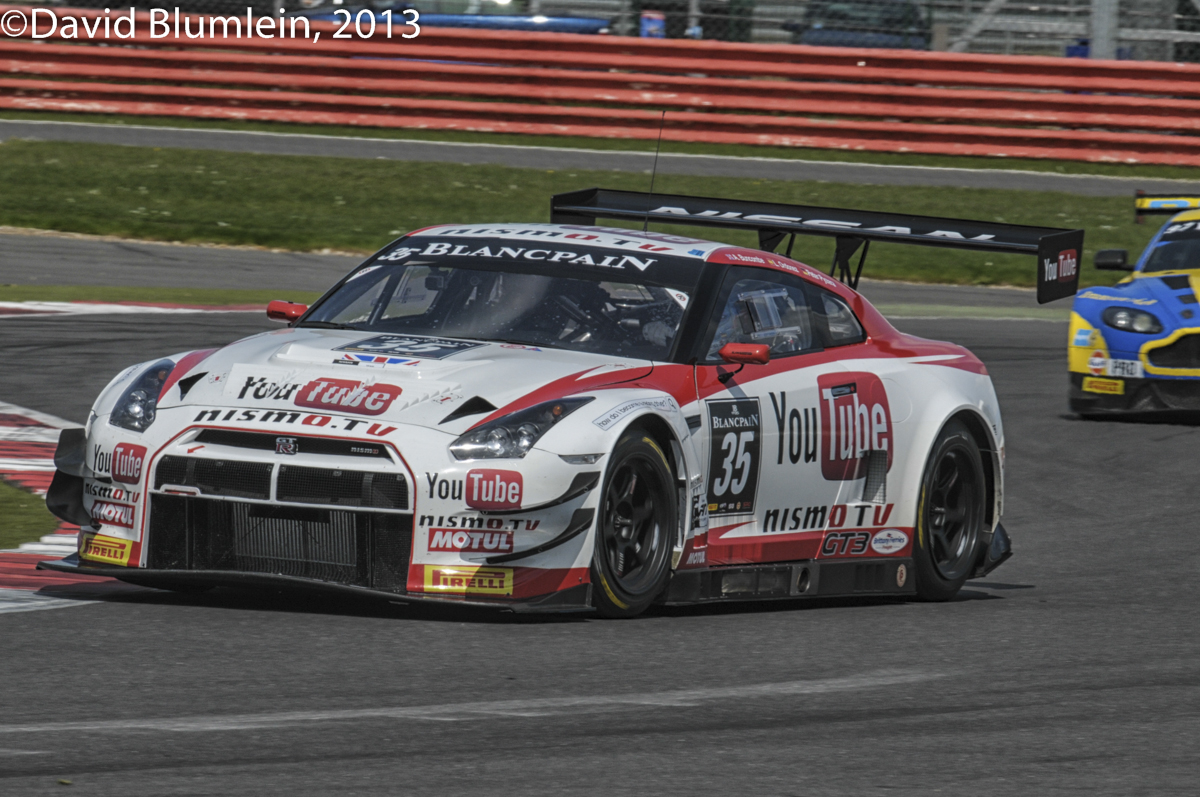
Also offering strong competition were the Nissan GT-R Nismo GT3s. The British team JRM has been developing these cars in conjunction with NISMO in Japan and was rewarded with 4th place. The RJN no. 35 machine even led the winning Aston in the early laps, in the end it won the Pro-Am category, finishing 10th.
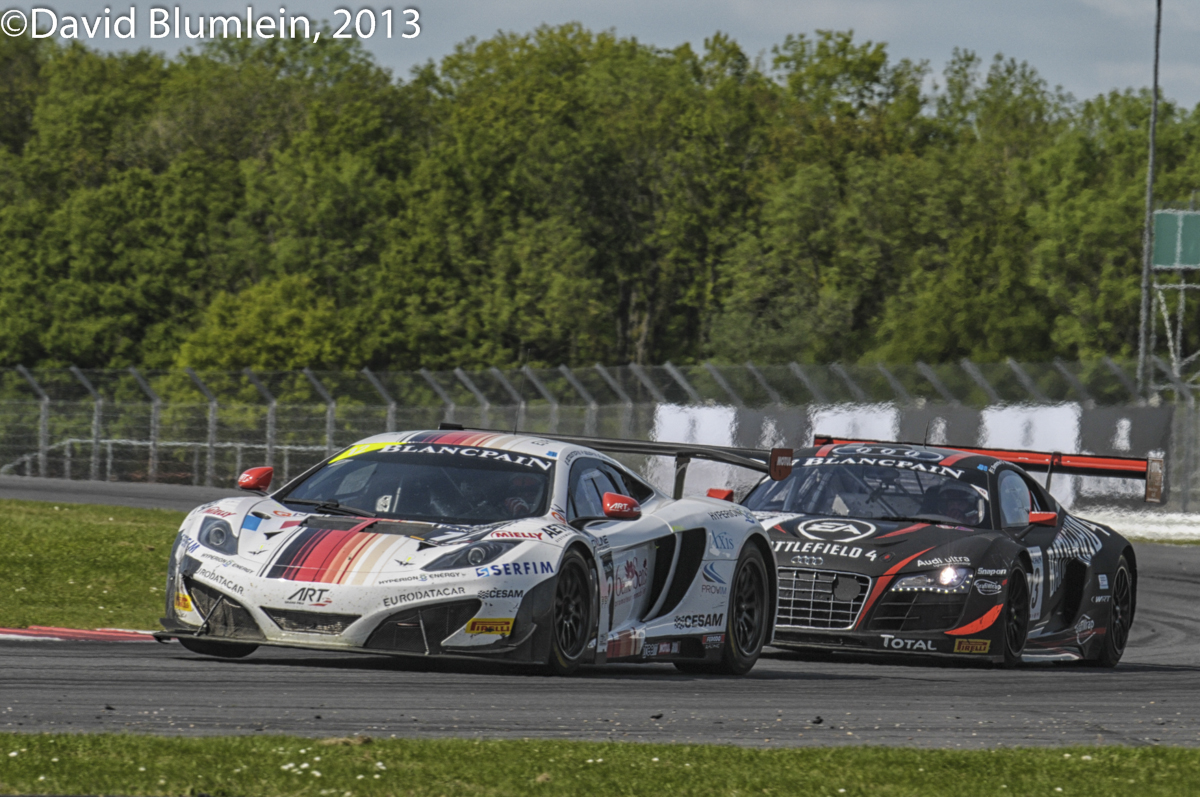
Disappointing were the McLarens – their best result was 7th courtesy of the Hexis team who had much success formerly with their Aston Martins. Like several others they elected to use the Woking cars for 2013 but these new cars seem to be off the pace at the moment. Above is the French ART Team MP4-12C three-wheeling out of Becketts.
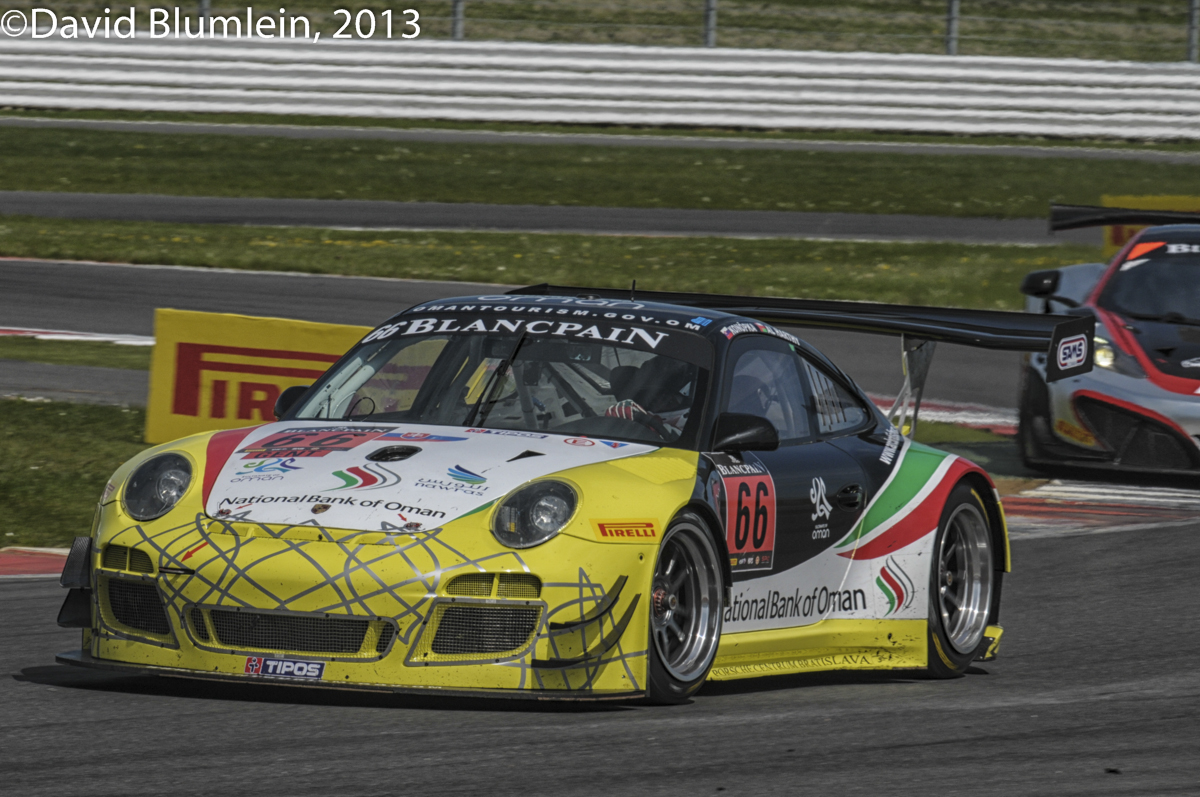
One of the particular joys of endurance sports/GT races is the presence of the subsidiary classes, especially when they throw up unexpected winners. Such was the case with the Gentlemens’ Trophy, the GTR category. This Slovakian-entered Porsche 997 GT3 R of the ARC Bratislava team came out top of the thirteen starters:
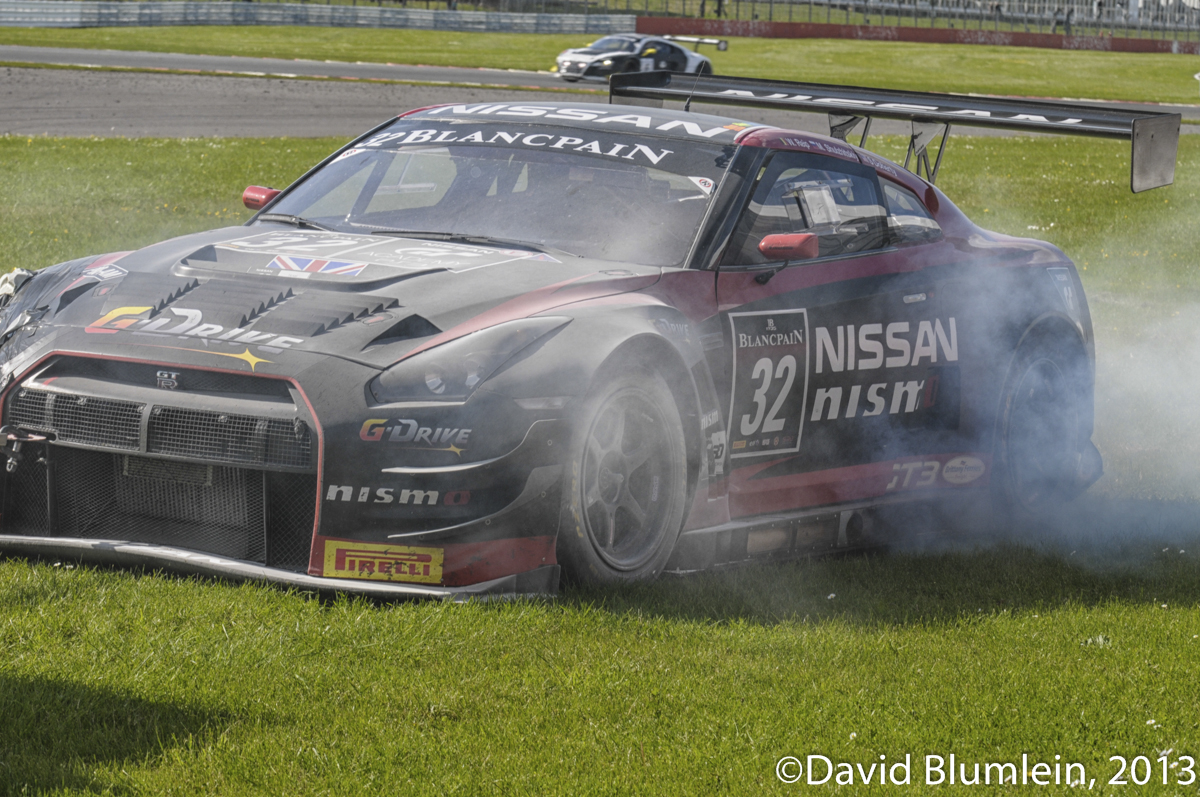
Of the original 57 starters overall only 9 cars were unclassified, a most satisfactory reliability rate. Alas, one which failed was this Nissan GT-R NISMO GT3 which understandably could not recover from an under-bonnet fire.
David Blumlein July 2013
It has been a quiet time here on the DDC front, in common with almost everyone else, the 2013 Le Mans 24 Hours wiped us out. However green shoots are now emerging and first up is a look at a cool car show that happened earlier in California. So thanks to Lizett for the eloquent copy and to Bruce for the stunning imagery.
There’s something really gratifying about witnessing an event take on a life of it’s own, and after five years that’s exactly what is happening here. That satisfaction intensifies when the gathering benefits a worthy cause. Throw some star power into the mix and you have a potent prescription for long-term success.
Based each year on a McQueen movie theme, The Sixth Annual Friends of Steve McQueen Car and Motorcycle Show, held in June, revolved around The Great Escape. The one-day a year event featured more than 300 cars and nearly 100 motorcycles on display to approximately 5,000 attendees. The proof is in the numbers.
“The first year we made about $14,000 with about 200 cars,” said co-chairman, Ron Harris. “This year we approached $250,000.
The cause is the Boys Republic of Chino Hills, CA. Established in 1907, the school is a private, non-profit community for at-risk teens. Steve McQueen attended from 1947-49 and credited the school for pointing him on the path to success. McQueen never forgot and was a frequent visitor, even after he became a Hollywood star and legend.
“He stayed in constant touch with the school and when he passed away, he left a nice chunk of change to build a recreation center,” said Chad McQueen, son of the famous actor.
The McQueen family continues that involvement through the car show and other activities.
This year, spectators enjoyed a diverse collection of the classic, the expensive and the rare. Highlights included Bruce Canepa’s Coooper T-52 Formula Junior and Chad McQueen’s black Speedster, both owned at one time by Chad’s famous father. A very original 1965 Ford GT40, 1949 Belly Tank Lakester and Roush Mustang were crowd favorites. A 1935/41 Miller-Ford NOVI-Winfield drew many admirers, as did the impressive gathering of Porsches and Mustangs. Steve McQueen’s love of all things two-wheeled are well documented and the motorcycle display paid tribute with affection. The man would have applauded the choice of the 1940 Zundapp motorcycle with sidecar that was the recipient of The Great Escape Trophy.
When it comes to war movies, director John Sturges 1963 film, The Great Escape, is likely on every World War II aficionado’s list of “must haves”. As the car crowd mingled and strolled the Boys Republic campus, a realistic reproduction of Stalag Luft III, the POW camp depicted in the movie, stood as silent sentry, complete with guard tower, cooler, tunnel, and barbed wire fencing.
The set exploded into life as the California Historical Group, a World War II living history association, re-enacted the legendary escape scene portrayed in the film, complete with McQueen’s character, Hilts, infamous motorcycle jump atop a Triumph SR6 650 masquerading as a German GMW R75. Rifle-carrying German soldiers fired on the M4A1 Sherman tank as a P-51 Mustang, complements of Chino Airport Planes of Fame Museum, performed a flyover.
“The show gets bigger and better every year,” said Chad. “Of course, we have the Porsches, which will always be standard fare with my Dad, but also a pretty eclectic mix of cars and motorcycles.”
Chad said he has so many memories as a small boy with a famous father. He offered this recollection of the film Le Mans:
“You had a young kid and his whole life was cars and motorcycles and nothing else. I was there for five months surrounded by racecars and racecar drivers. I was ten. It was just sensory overload. I think the high point was my Dad putting me on his lap for a ride in the 917, that was pretty bitchin’.”
Anyone out there care to disagree ?
Lizett Bond, July 2013
The first of the three great endurance classics was a week or two ago. The weather Gods frowned upon the event and yet those of us who got cold and wet were still smiling A bad day on the Nordschleife is better than good days most anywhere. Our Special Correspondent braved the elements to bring you this commentary. Danke!
It is not often that one drives down the main street in a town and passes under a bridge that looks just like a typical railway bridge except that it isn’t! No, this bridge (on the left) carries the race track of the Nϋrburgring’s Nordschleife (northern loop), and the track climbing up to the right can just be seen. This is the Adenau section of the circuit and the cars come down the hill from the left, cross the bridge and charge up the right hander on their way to Bergwerk.
A race circuit cutting through a town’s normal buildings – magic!
The Nϋrburgring 24 Hours 2013 will go down in history for two main reasons. First, it contained the longest enforced suspension of racing in the 41 races run so far owing to the impossibly wet weather conditions – it was red-flagged at 22.44 p.m. when visibility was practically zero and racing only resumed at around 8 a.m. on the Monday. (Fog had already caused a stoppage in 1992 and 2007, and in 1973 the race format called for two 8-hour heats with an 8-hour break between).
Secondly, this was the first win in the event for Mercedes-Benz – BMW had been victorious no less than 19 times, Porsche 11, Ford 5, Chrysler 3 and Opel and Audi once each. The Mercedes SLS AMG GT3 has been developed into a reliable car and it gave Black Falcon yet another 24-hour victory, providing also a first time win for drivers Schneider, Bleekemolen, Thiim and Sean Edwards, the first Briton so to triumph.
173 cars started the 2013 race with 36 retirements (in 2007 there were 224 starters!) but each year this fascinating event attracts scant coverage in the British motoring journals, so a brief look at some of the contenders should go a little way to compensate:
Aston Martin has long had positive links with the Nordschleife – who can forget the DBR1’s three successive wins in the 1,000 km races in 1957-59 thanks to the skill of C.A.S.Brooks and Stirling Moss with their three different co-drivers? The company now has a technical centre alongside the Döttinger Höhe section and has in recent years been a regular entrant in the 24 Hours. This year their works-backed Vantage GT3 shared the front row of the grid and was leading the race prior to the onset of the dreadful weather and the subsequent red flag. The wet conditions that persisted at first on the Monday morning did not suit the car and it had dropped back to tenth by the finish. The picture shows the car diving down to the Hatzenbach towards the end of the race.
This Opel Manta seems to be a regular fixture in recent editions of the 24 Hour race. The crowds love it because the model dates from the Eighties and once again it completed the race, this year in 100th position.
This Audi R8 LMS ultra of Phoenix Racing was one of the favourites, having sat on pole position at the start. Here it is climbing the rise out of the bridge at Adenau on its way to Bergwerk. After last year’s victory this was not Audi’s year – this car could not manage better than 8th.
Nor was it BMW’s! The Z4 GT3s are very potent machines with 4.4-litre V8 engines (the road cars use 6-cylinder units) but this car , again a favourite, finished only 6th. BMW honour was upheld by Maxime Martin’s remarkable drive in the last hour or so when he snatched second place with the Team Marc VDS Z4 GT3 thus spoiling a 1-2-3 Mercedes finish!
Peugeot has been scoring class wins in recent Nϋrburgring 24 Hour races with the RCZ coupés but this year they have been very anxious to promote their new 208 GTI model and all three of their entries completed the race, the best winning the class.
The GT4 class was hotly contested with Porsche no. 56 running away with the class initially but in the end this BMW M3 GT4 finished first in the group on the road followed by a Ginetta G50. Alas it seems that both cars have since been disqualified!
Cor Euser brought his GT4 Dubai 24-Hour class-winning Lotus Evora to the race in an attempt to repeat the performance. Unfortunately, American driver Shane Lewis not only crashed it in practice but out-braked himself in the race and damaged the car again. However, Euser does not give up easily and his team had the car repaired in time for it to do a final lap at the finish and qualify in 134th position.
Alset Global, a company pioneering a hybrid hydrogen fuel system, entered into a collaboration with Aston Martin to develop a car that could take part in an international race using hydrogen as the fuel. Aston Martin chose their newly-released Rapide S model as the basis of this and it was intended that it should have its first outing thus equipped in the Nϋrburgring 24 Hours. The car is a hybrid and used hydrogen for a lap or so at the start of each driving stint, the normal fuel for the V-12 engine taking over for most of the time. In the course of the meeting the car did the first ever lap of the circuit using hydrogen only and thus entered the history books.
This car was run prior to the 24 Hour race in the second and third VLN races (the first was cancelled) to get it race-worthy but it only used petrol on these occasions.
While on the subject of fuels, diesel cars have long had their own class in this race – BMW had the first outright win for a diesel car in an international race when it won here in 1998 – and the smoke being emitted from this 1-Series BMW confirms its diesel status – it went on to win the class ahead of a Seat Leon.
No Nϋrburgring 24 Hour race would be complete these days without the Manthey Team Porsches. Here is car no. 18 pedalled by the top works Porsche drivers. The flashing blue light in the windscreen is to warn drivers of slower cars that the really fast boys are approaching them!
TAILPIECE
Mission accomplished – the three Peugeot 208 GTIs arrive at the finish.
David Blumlein, June 2013